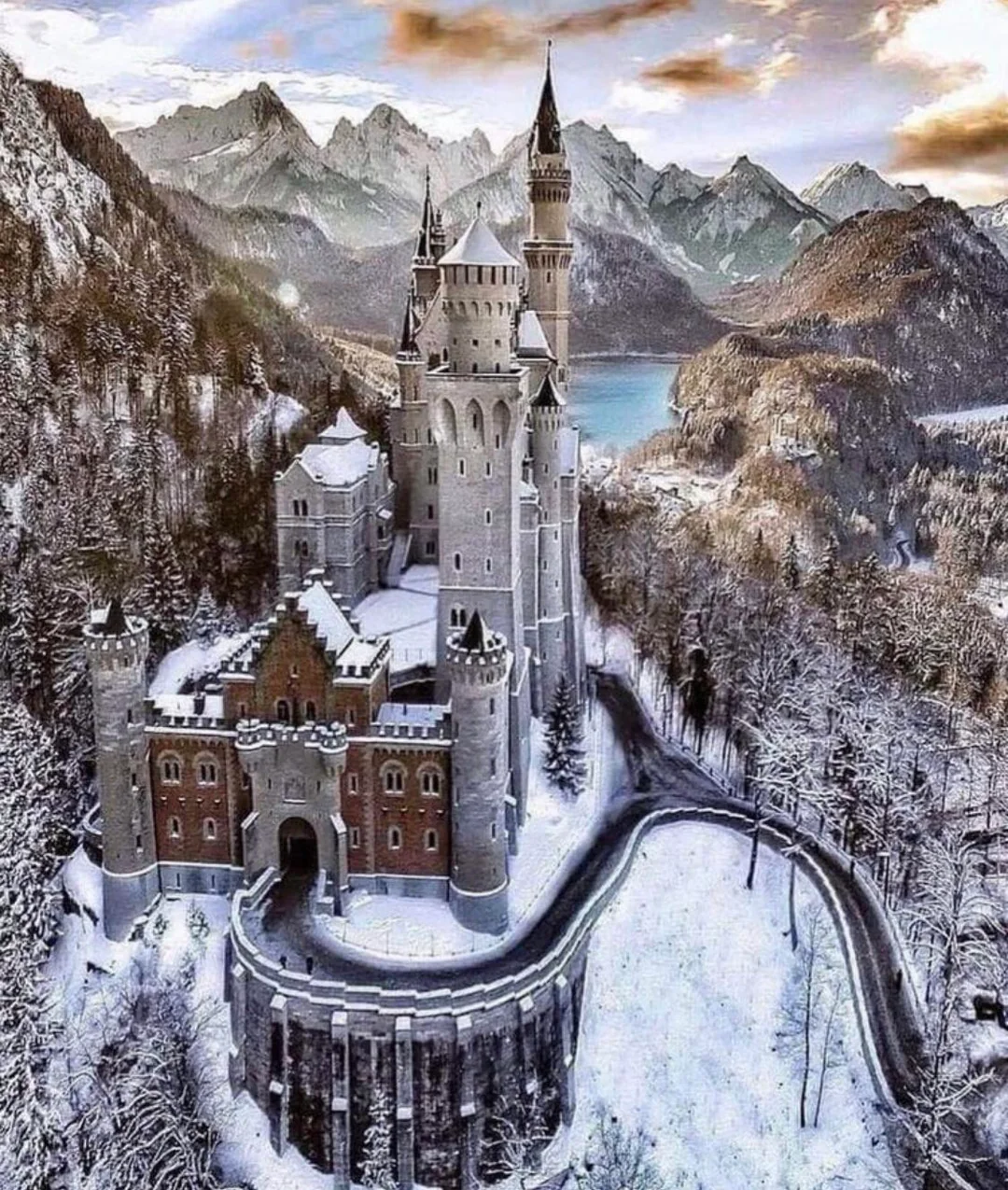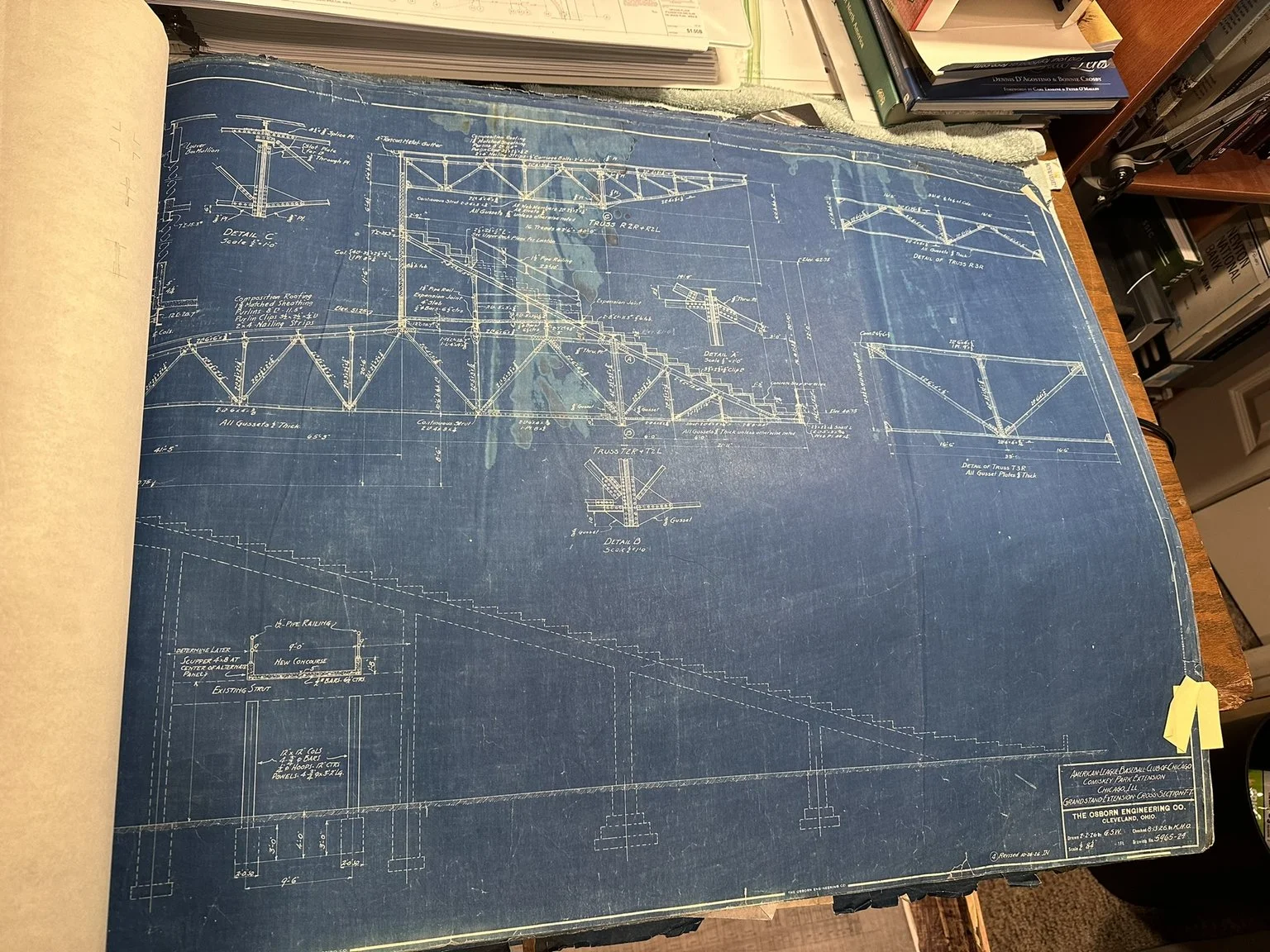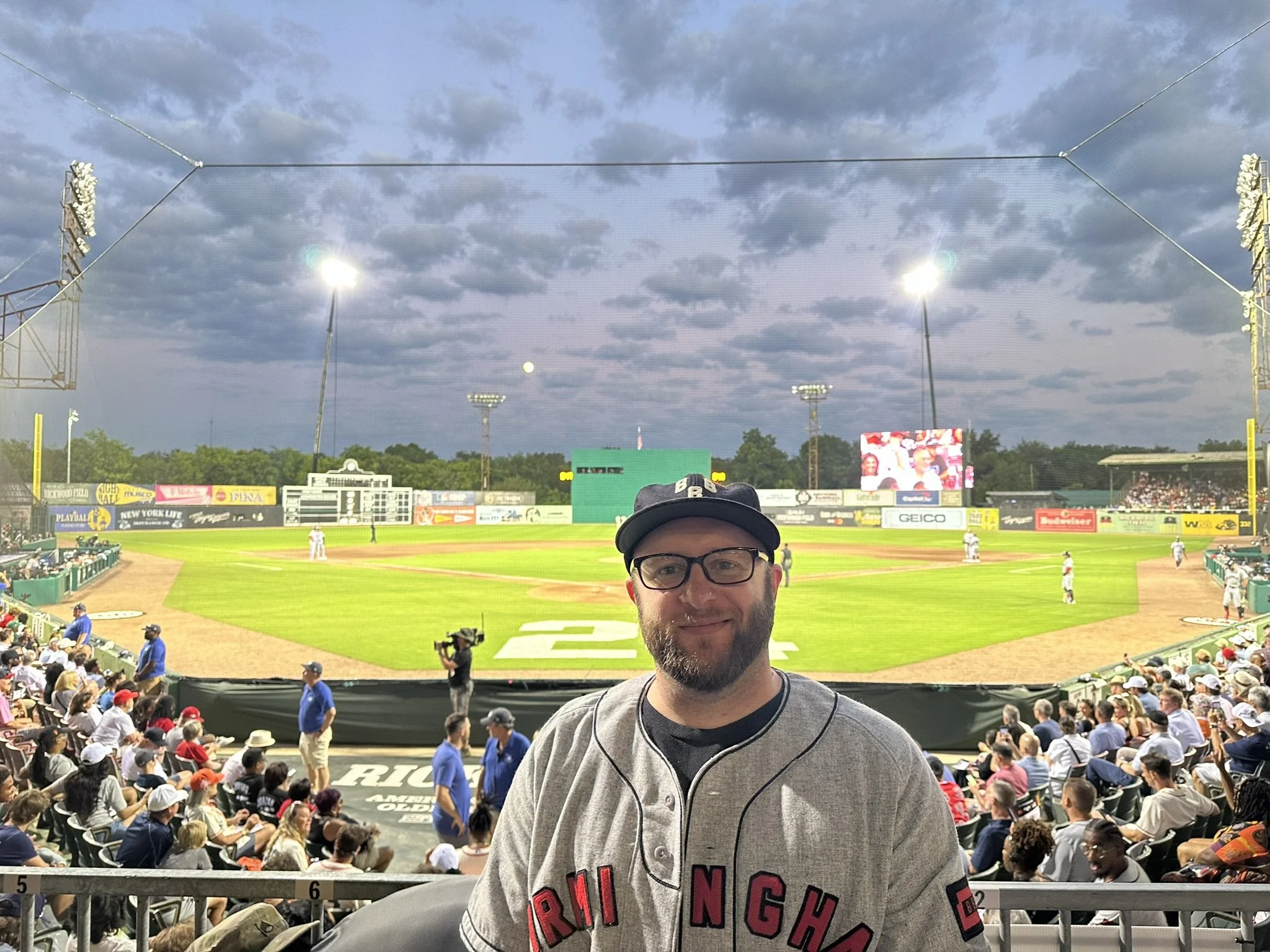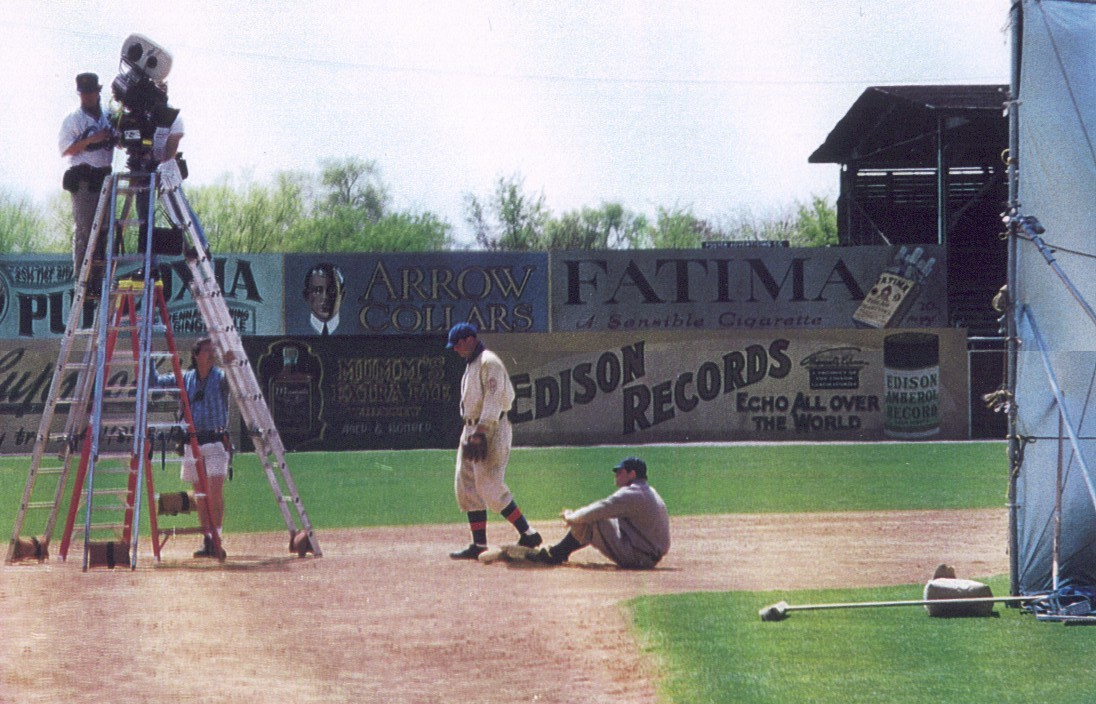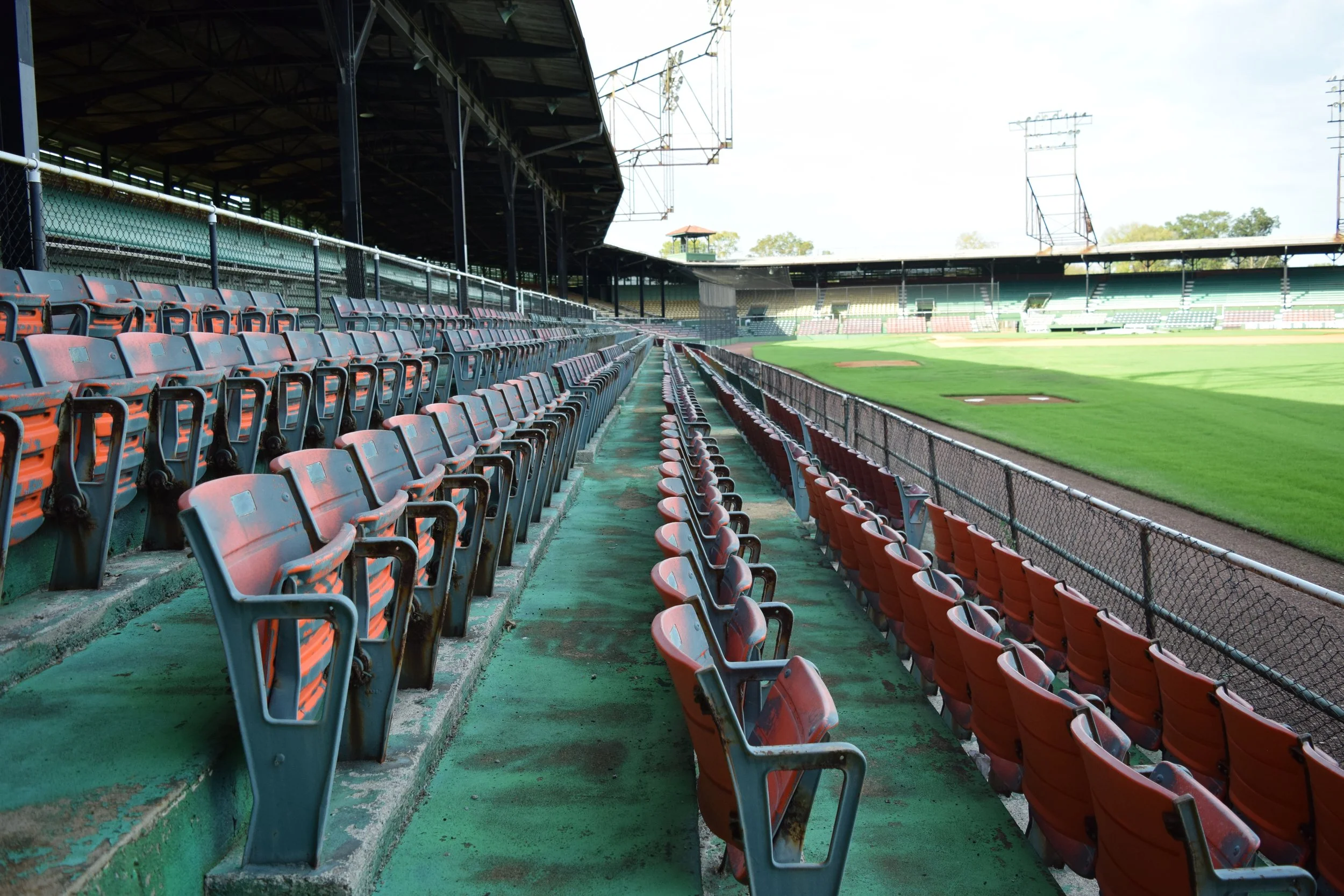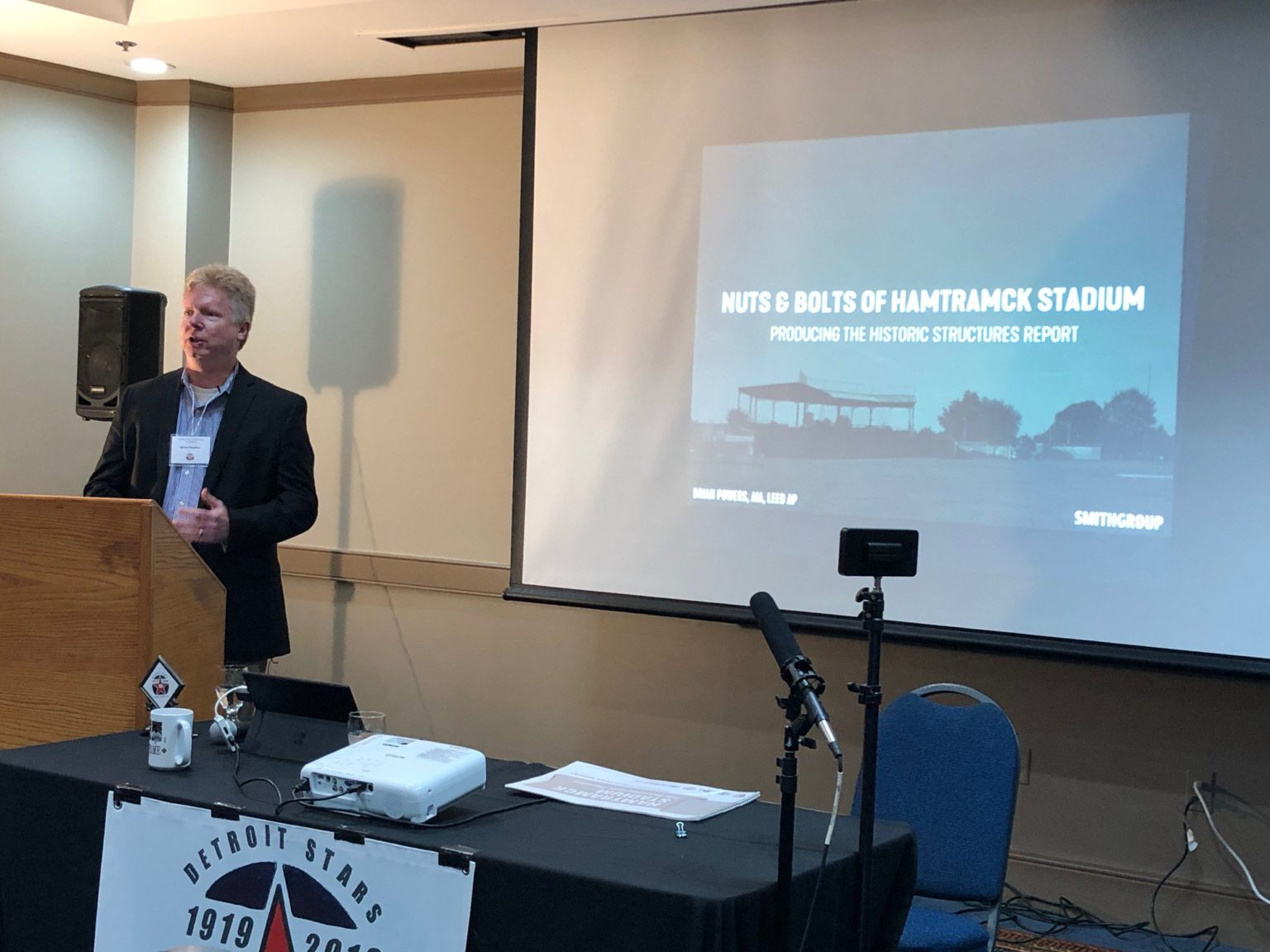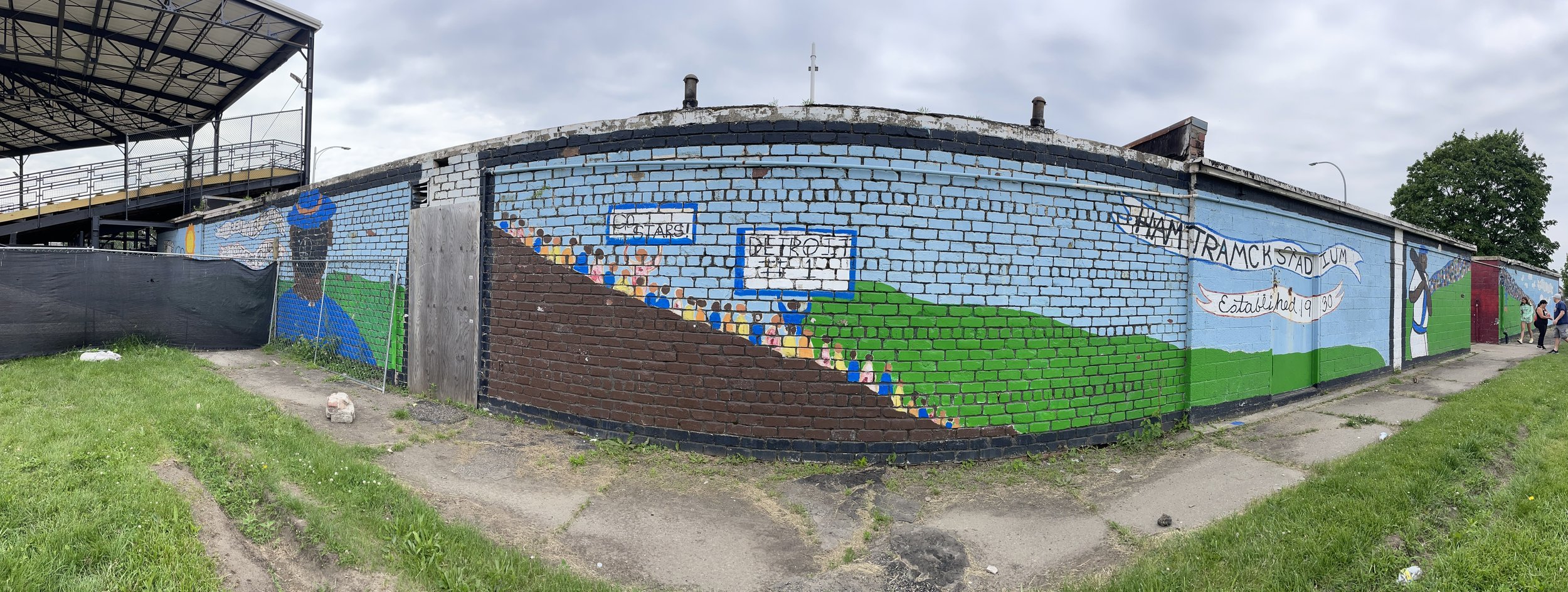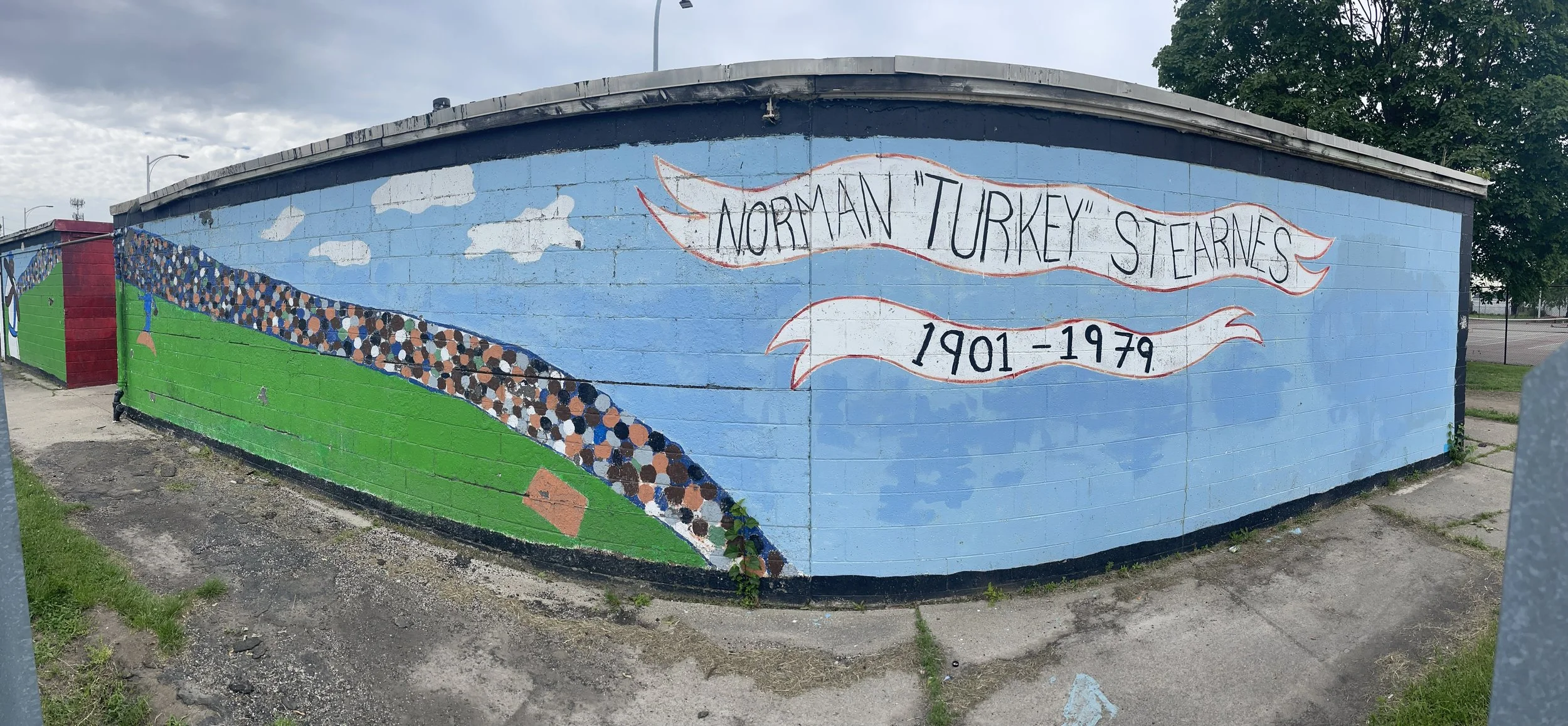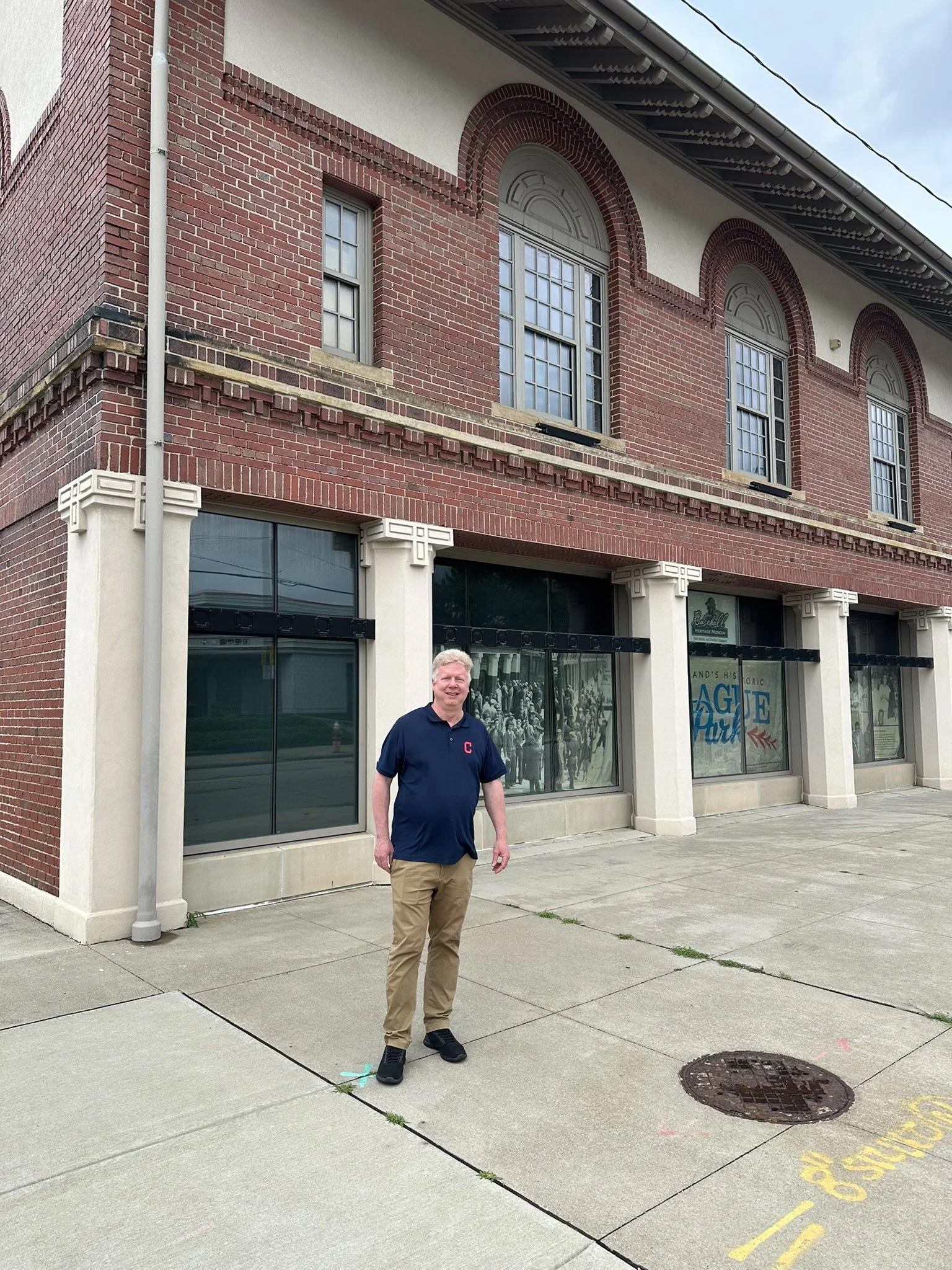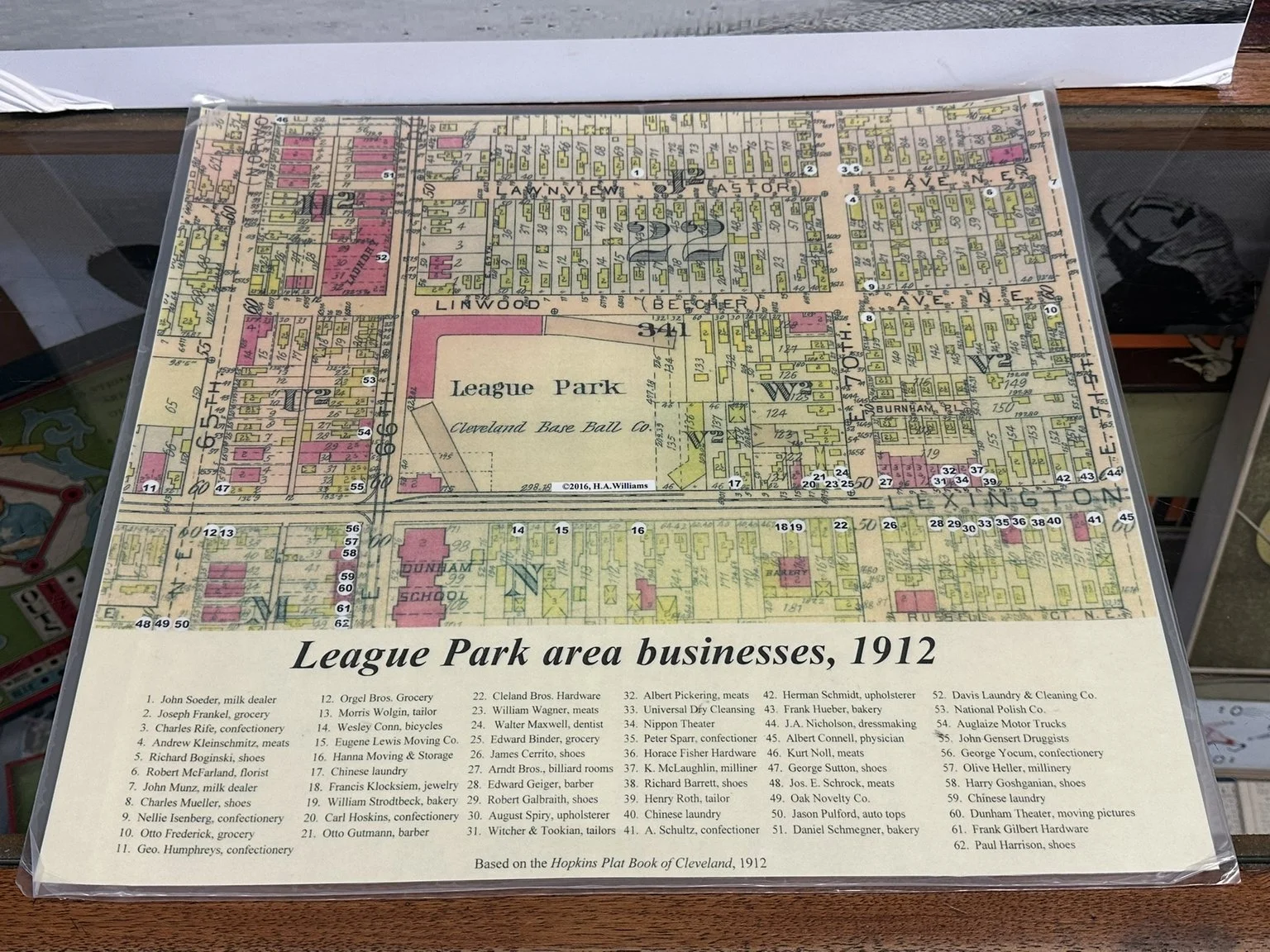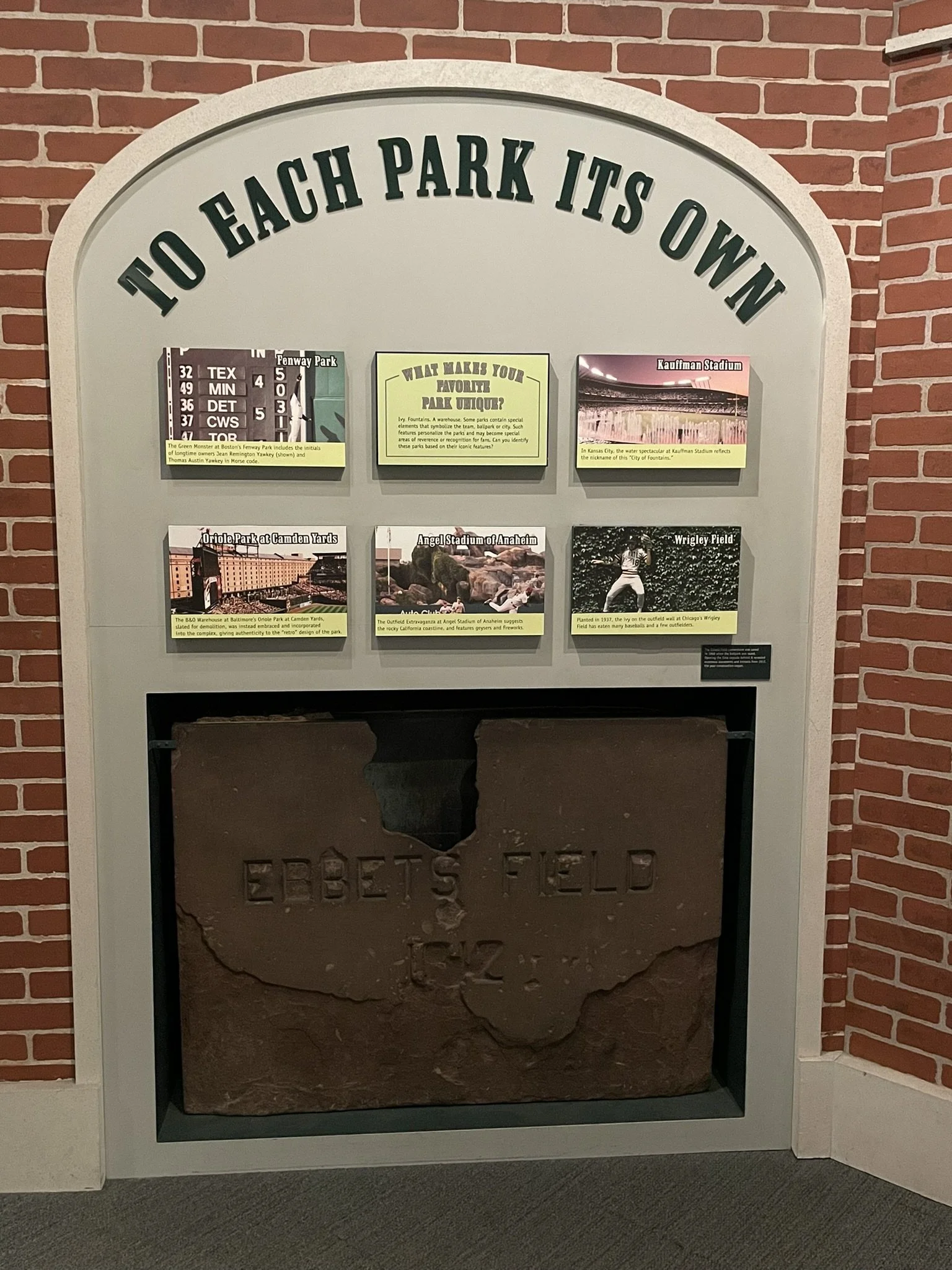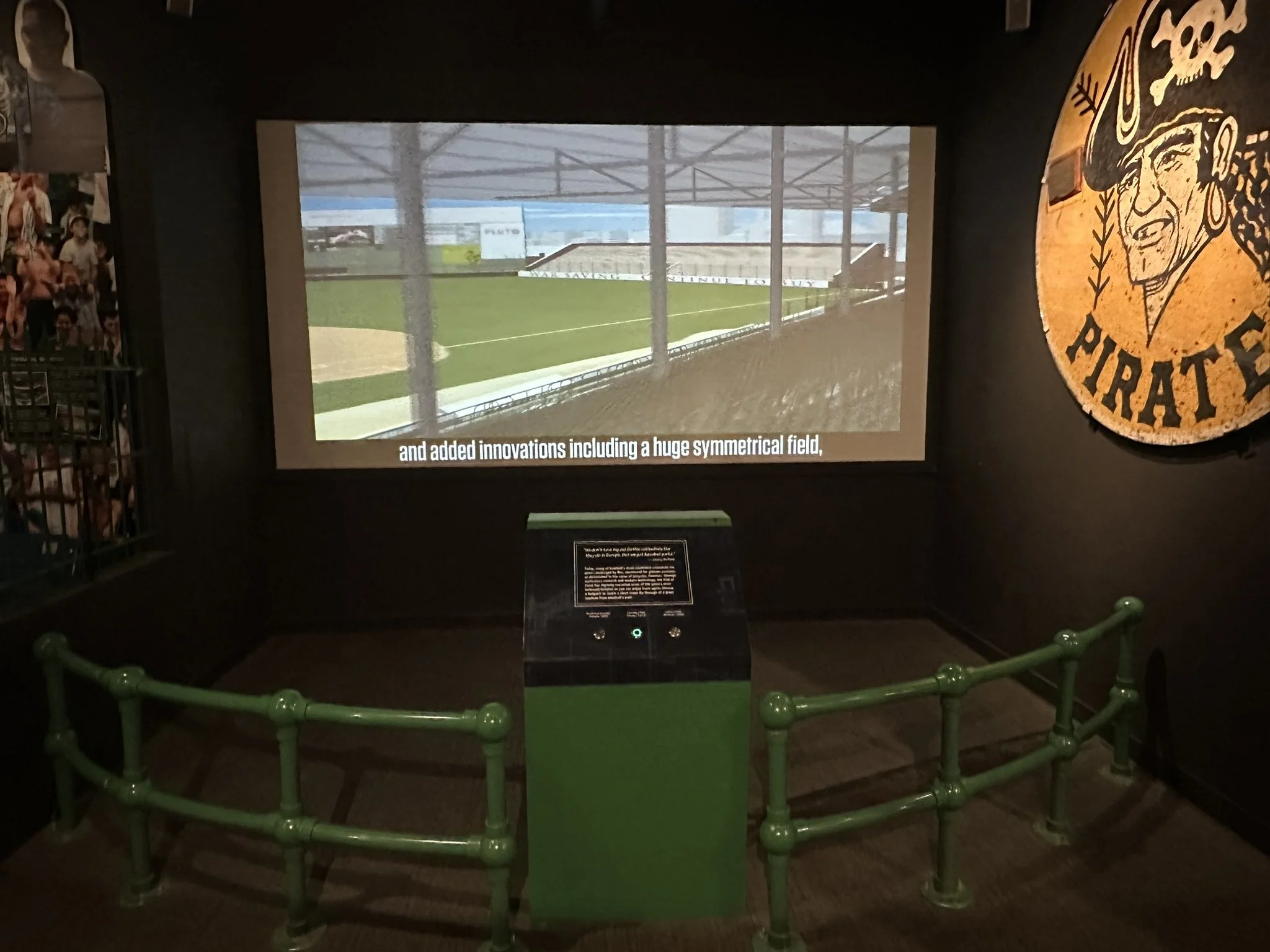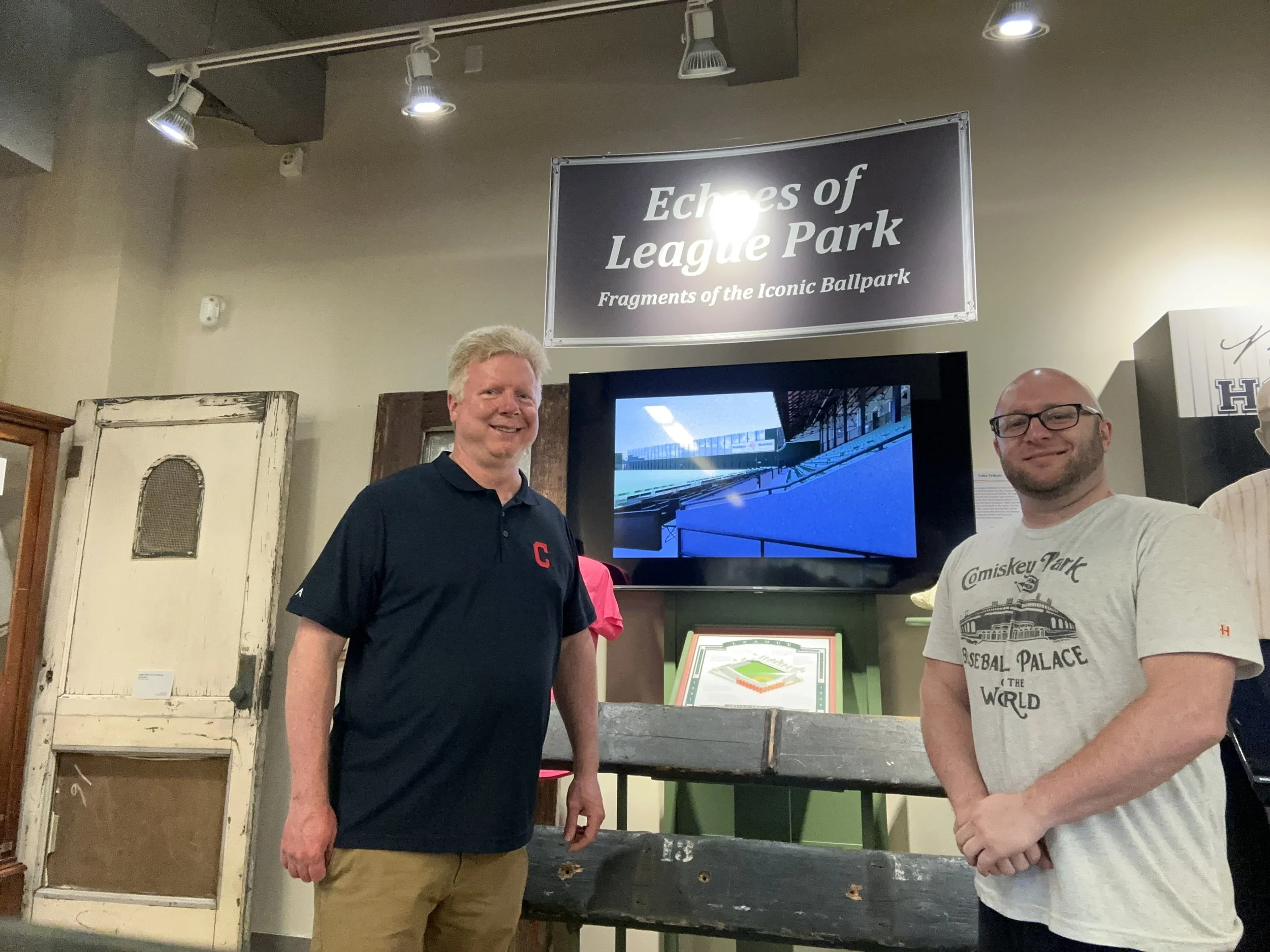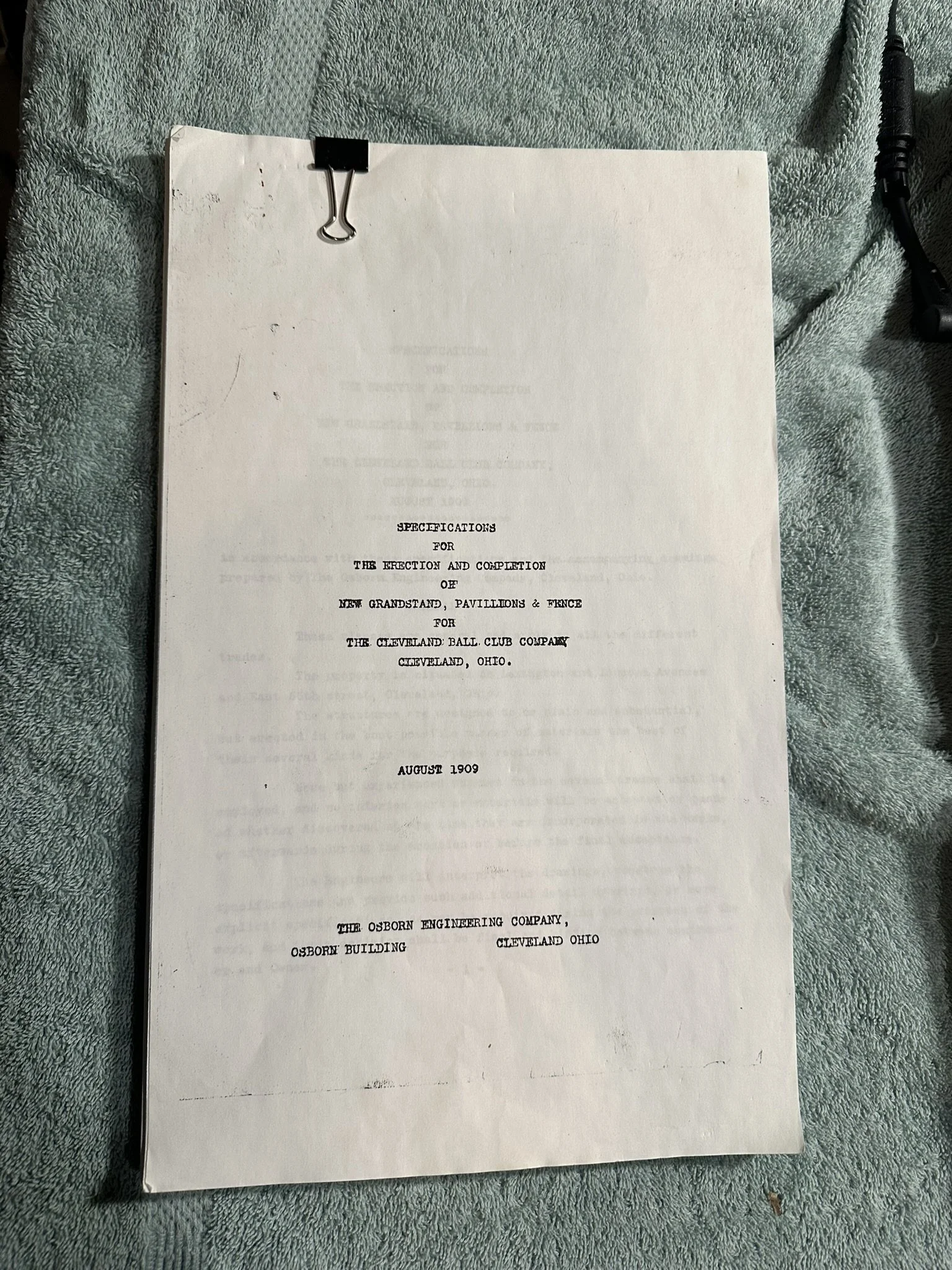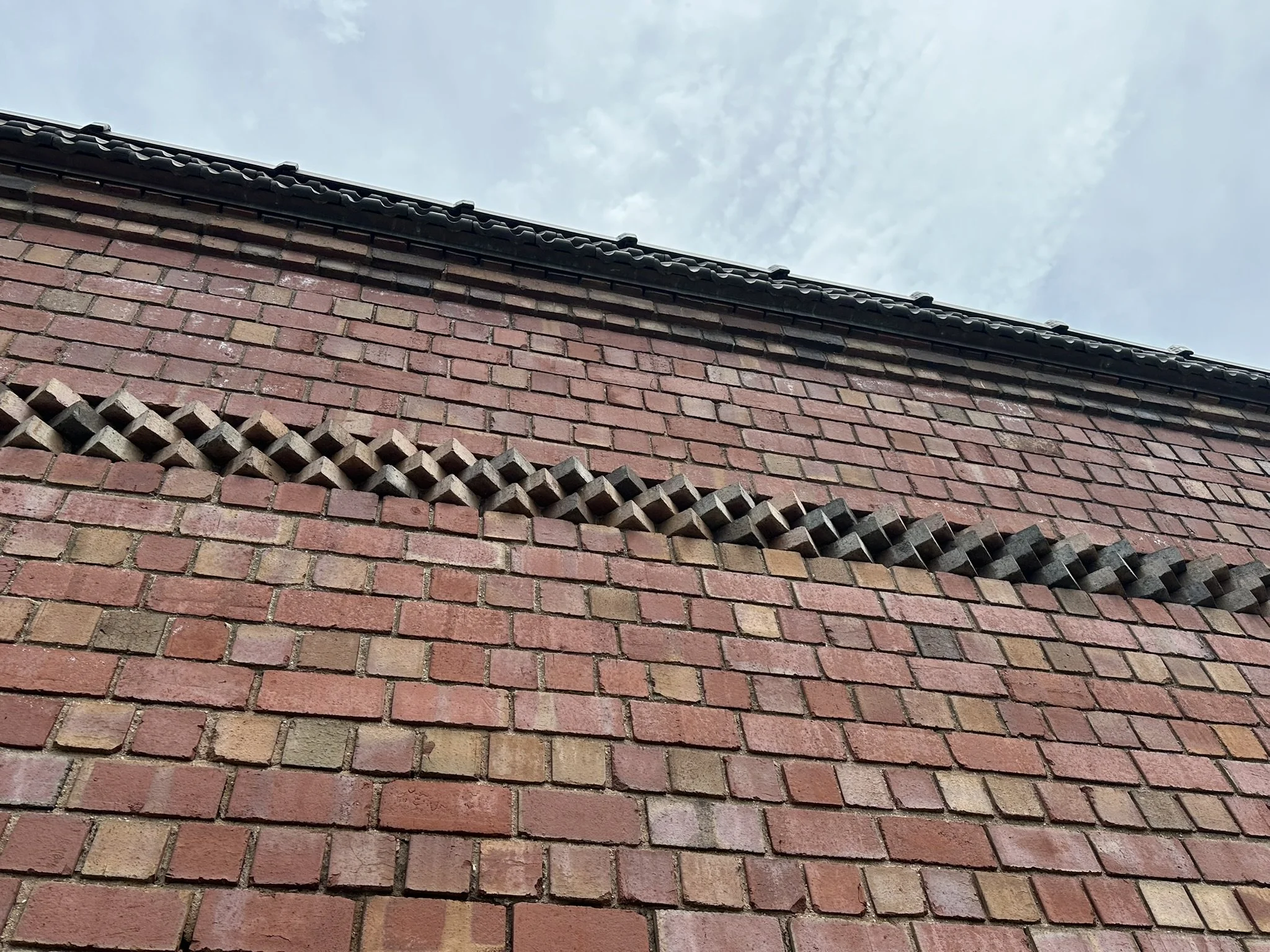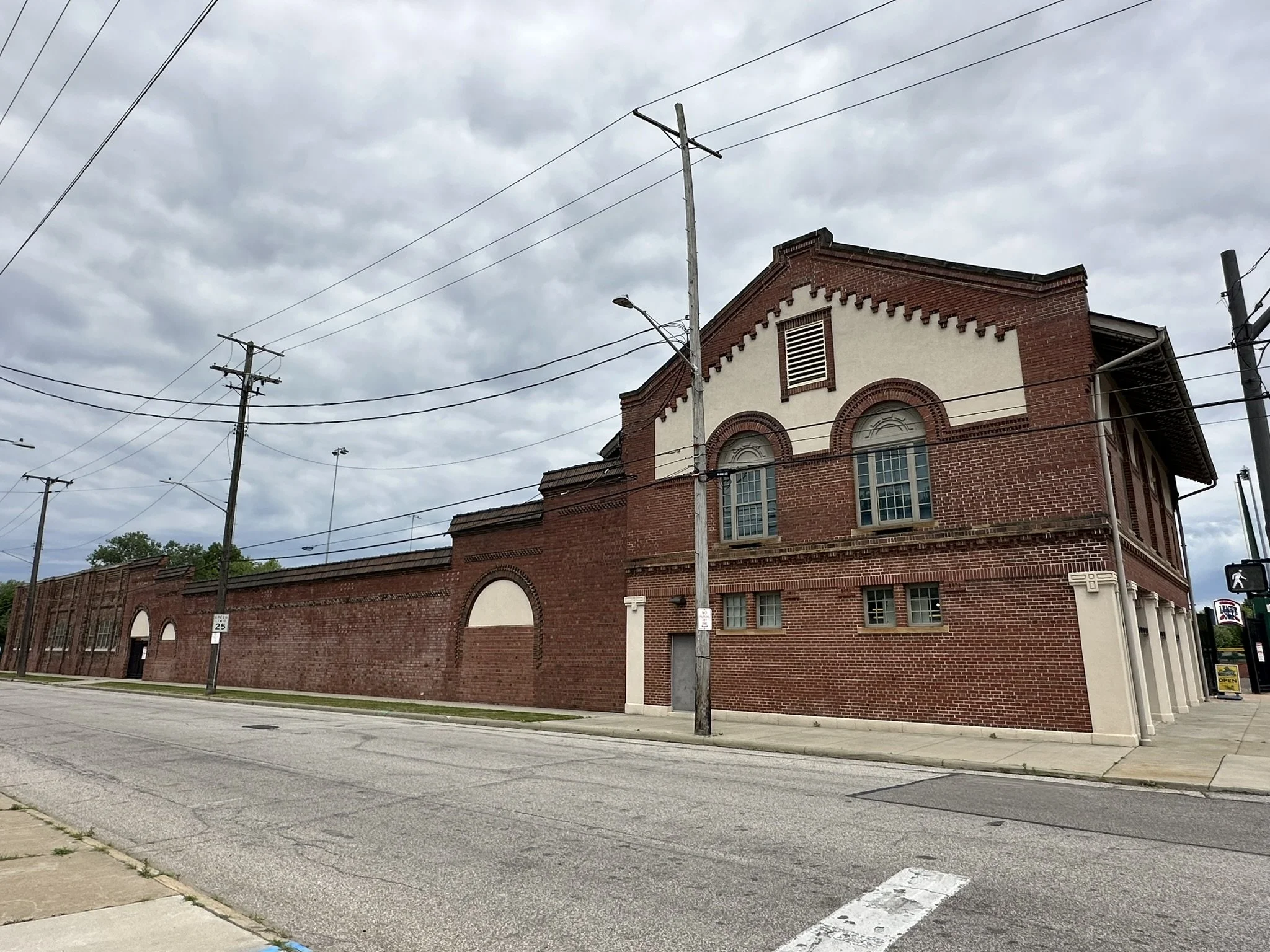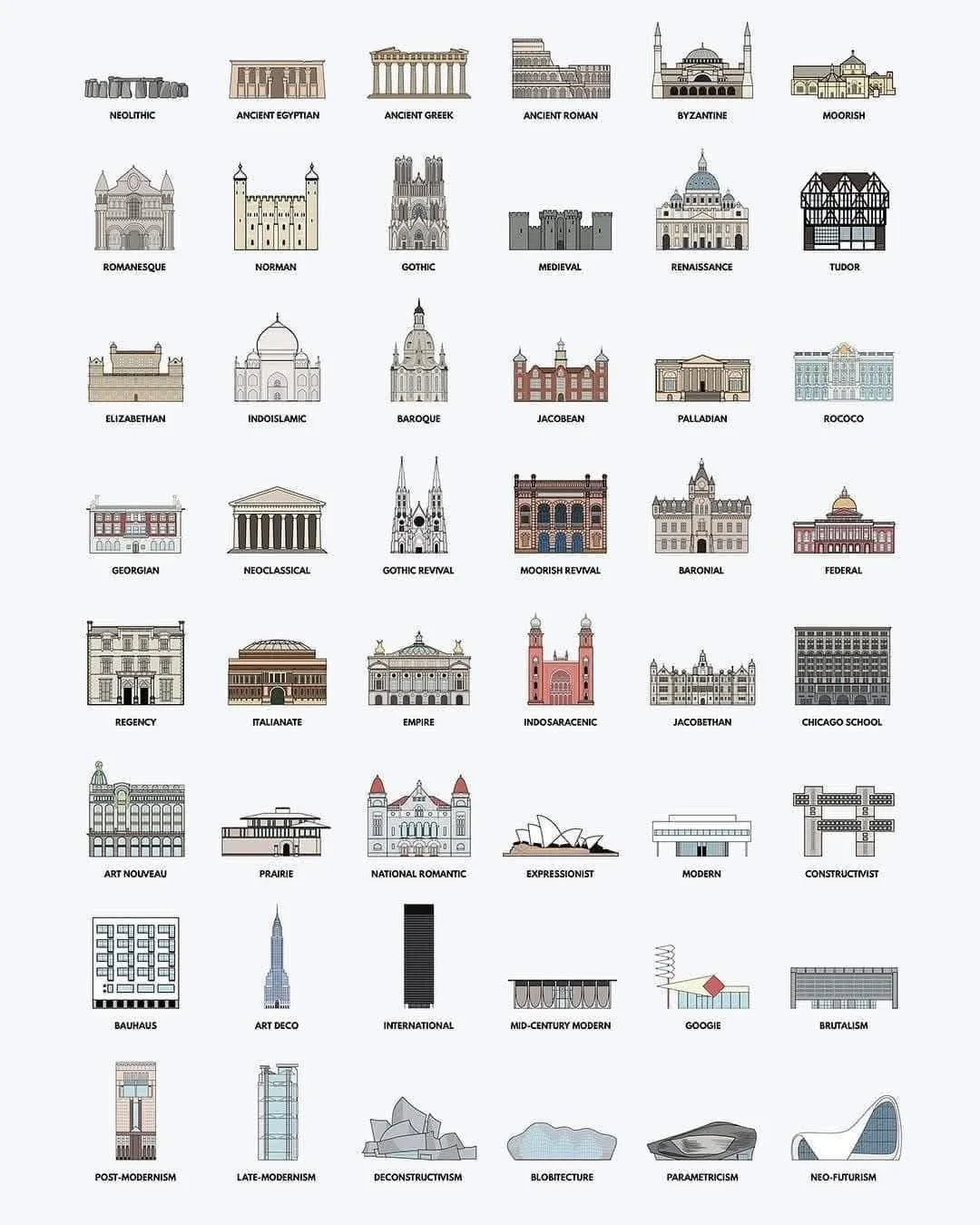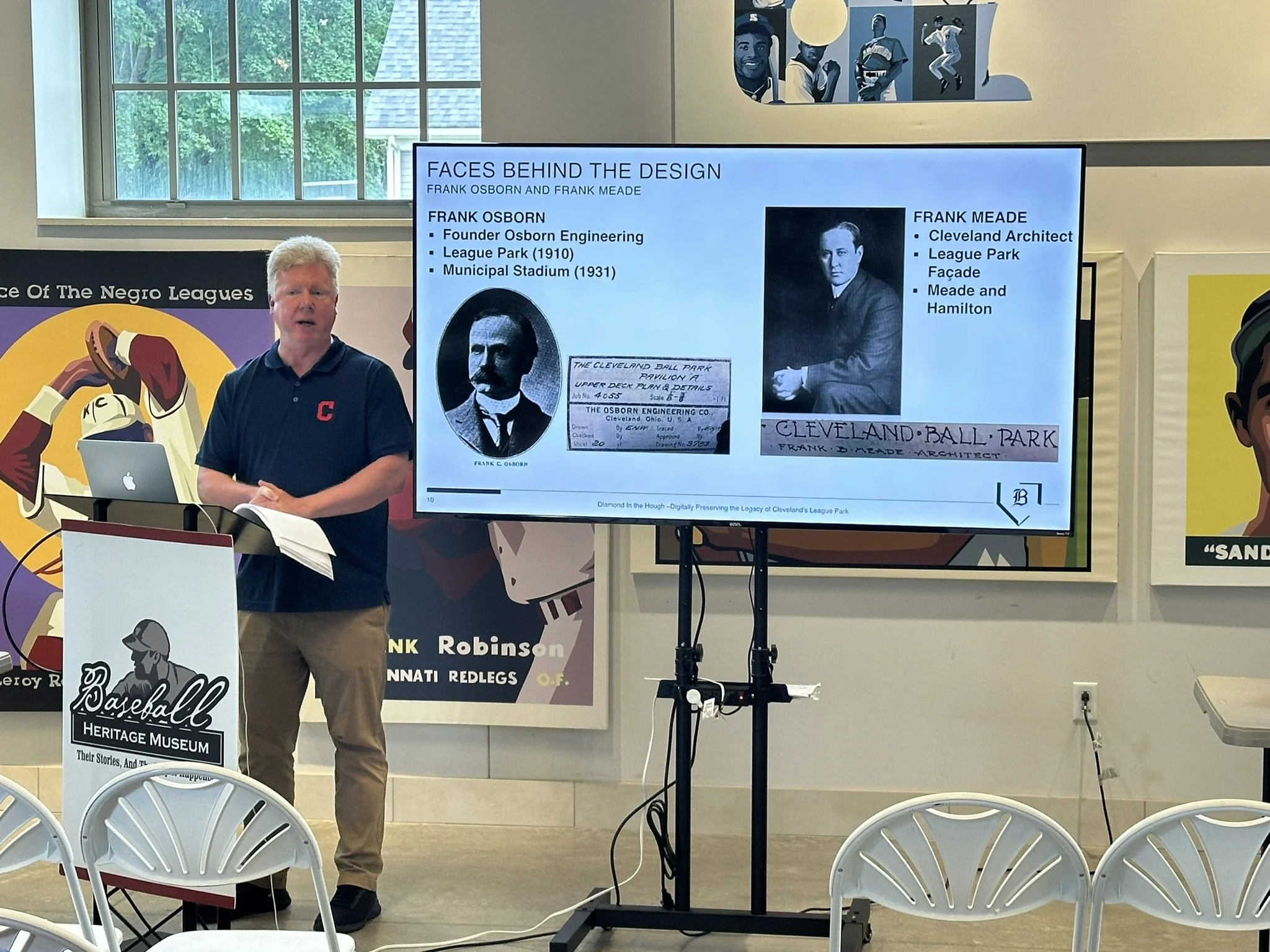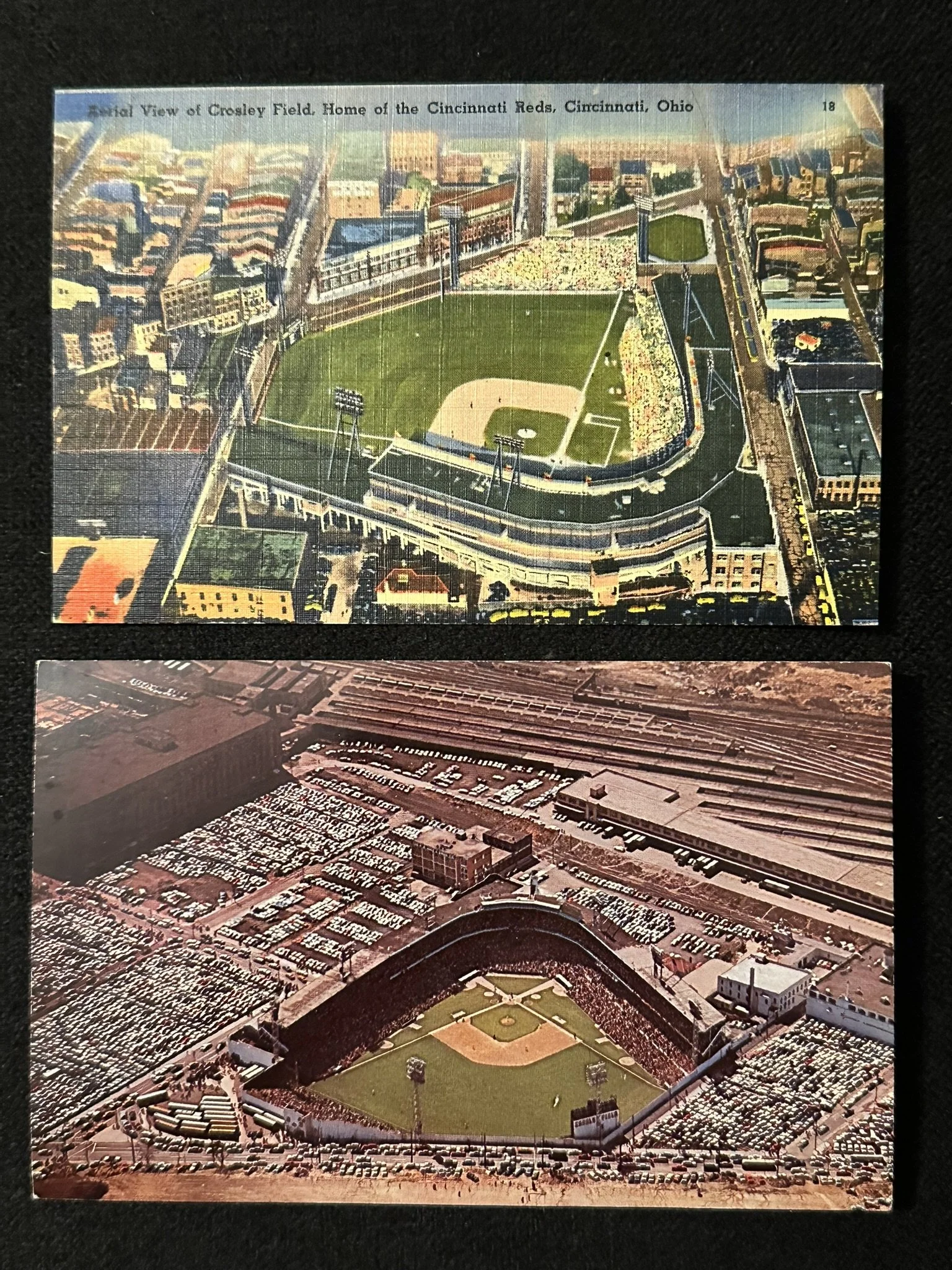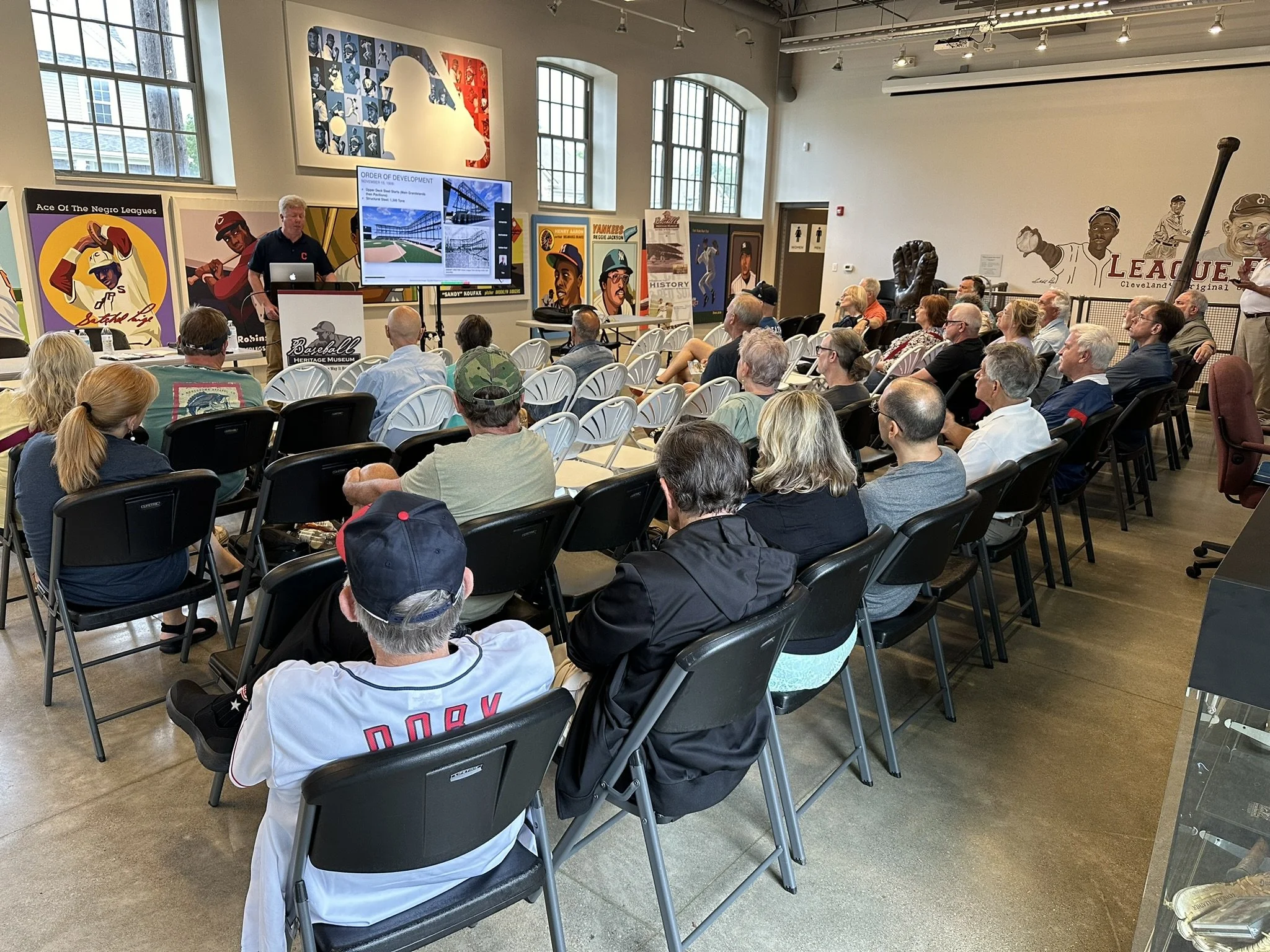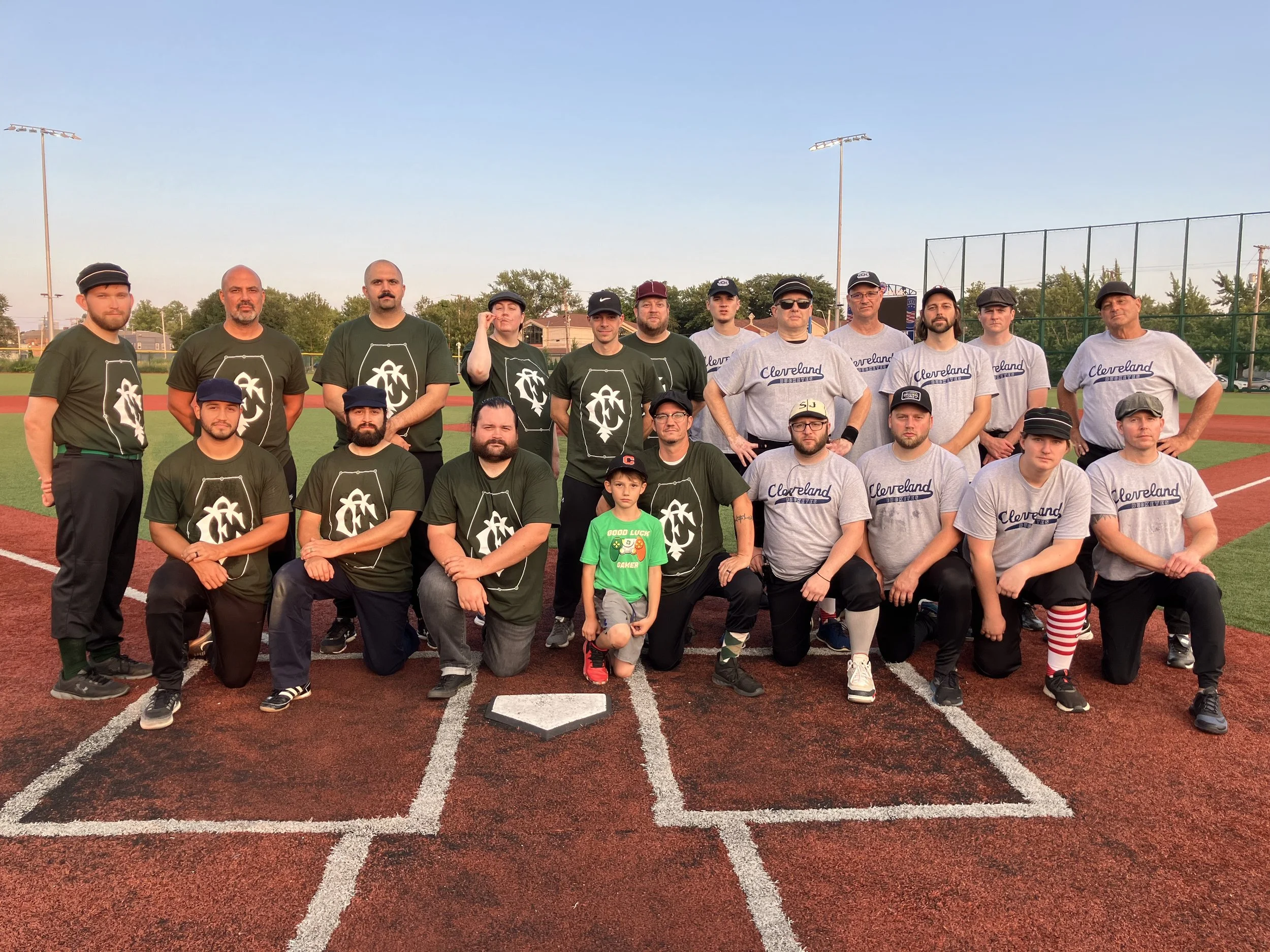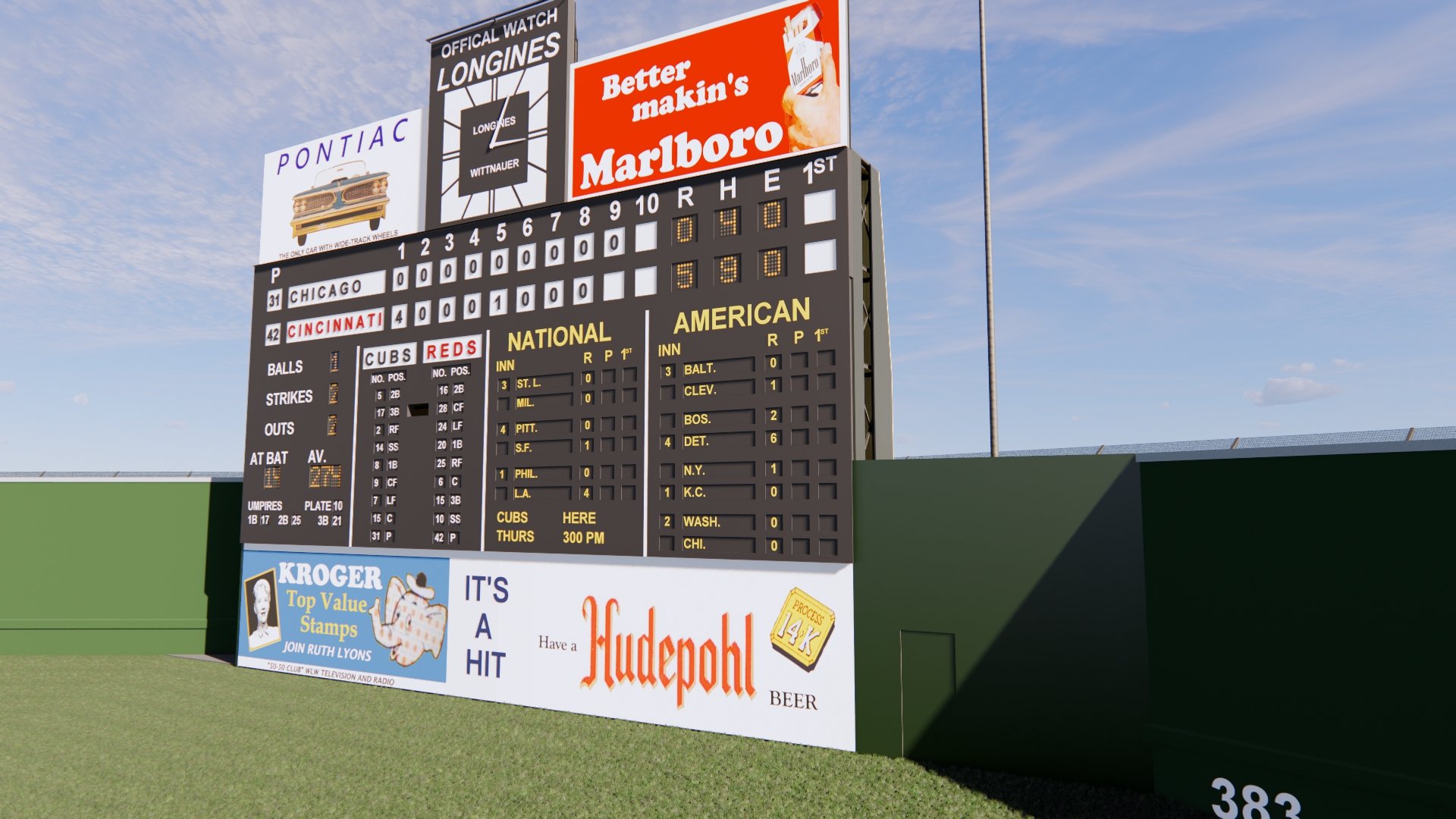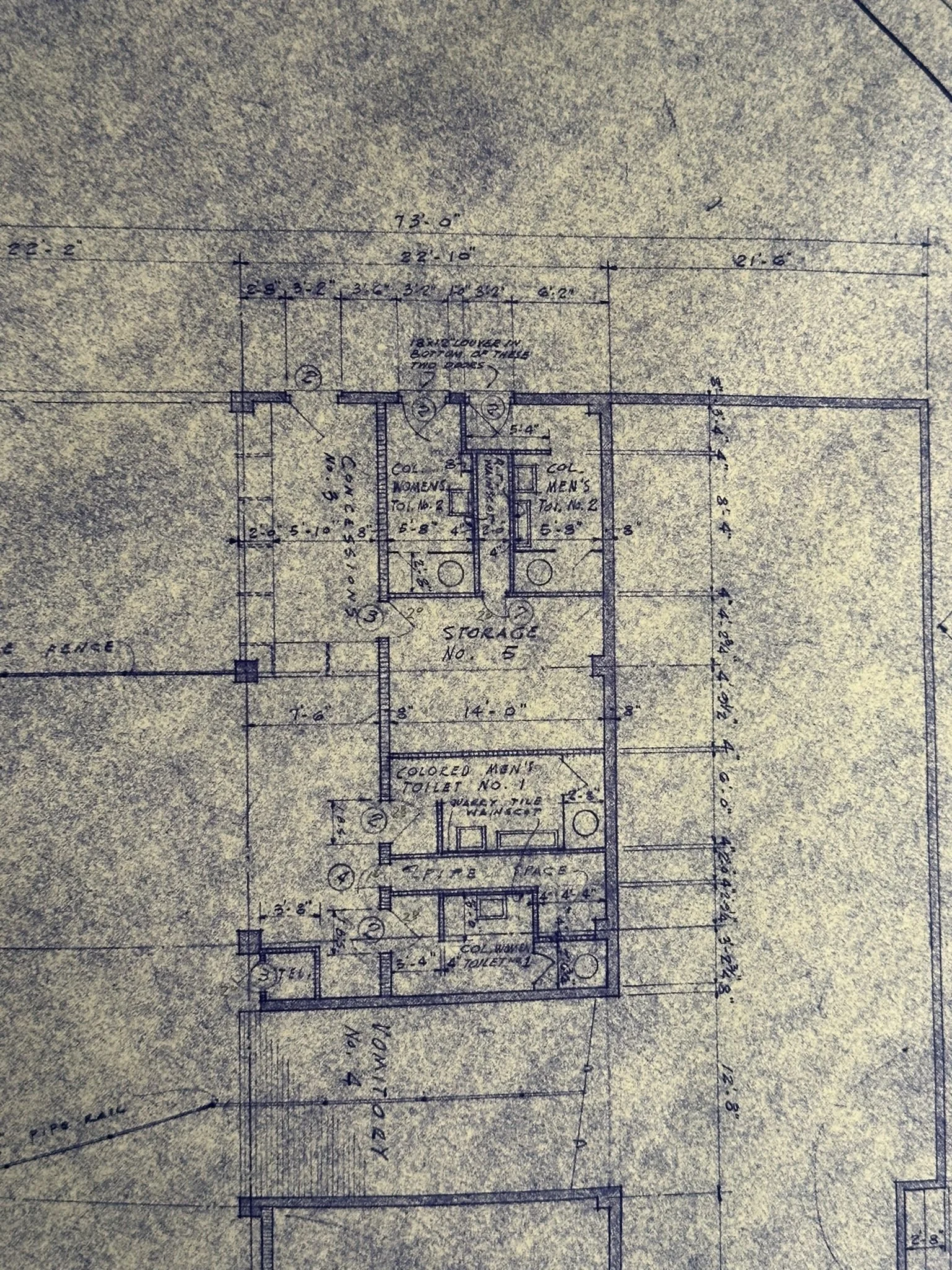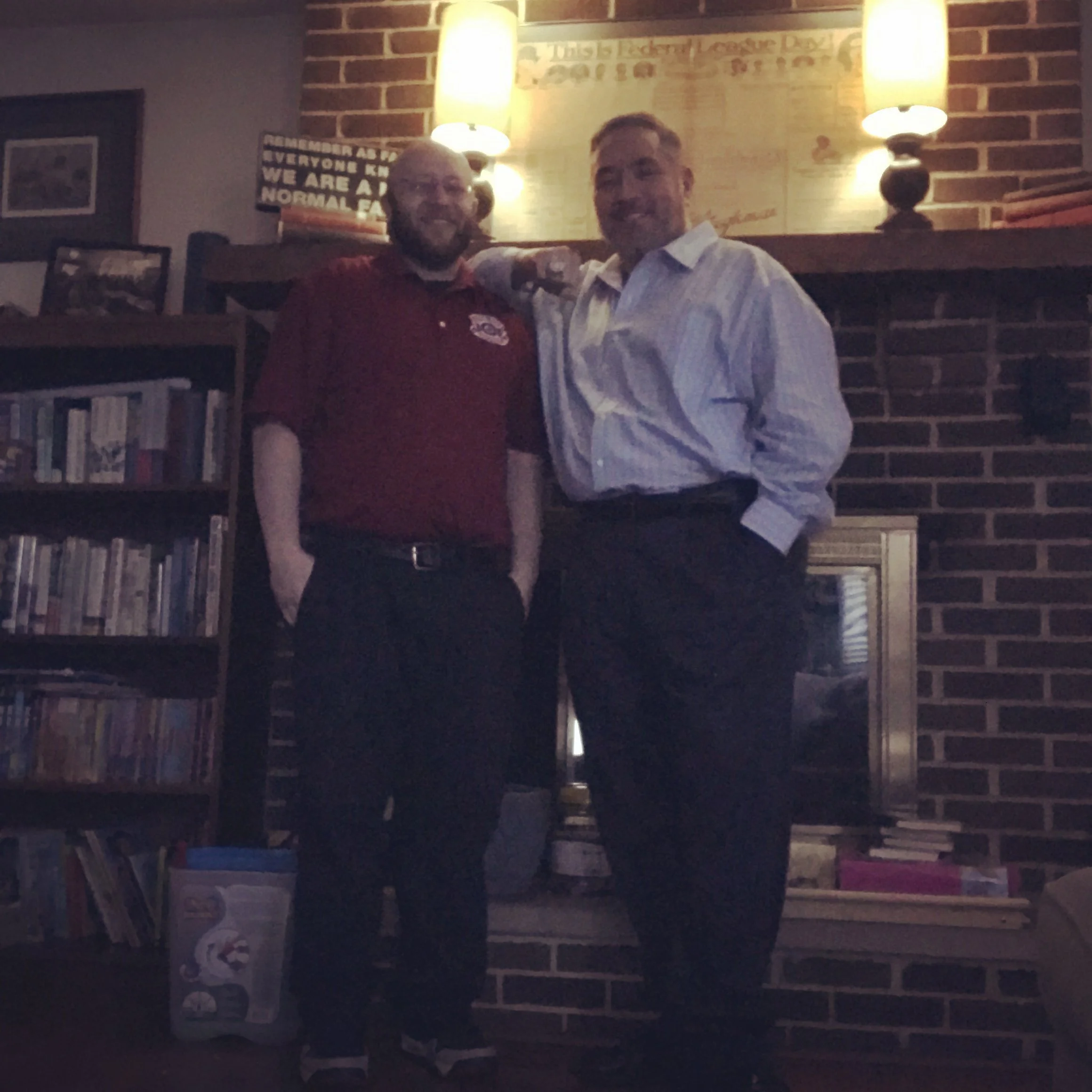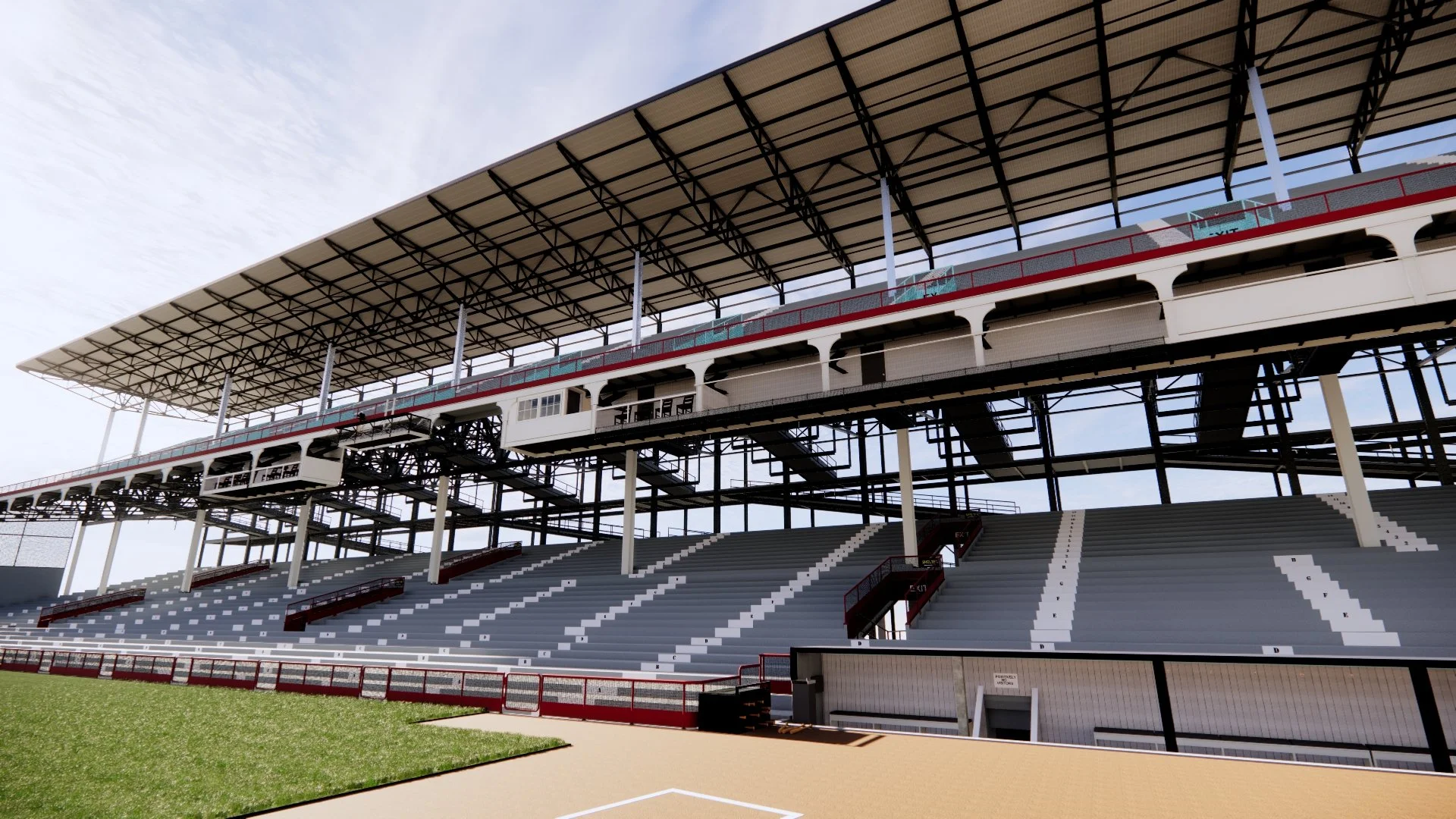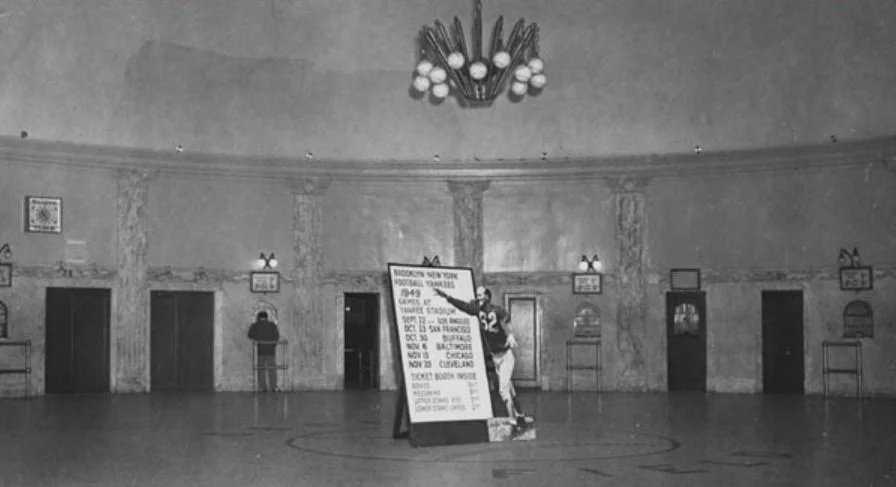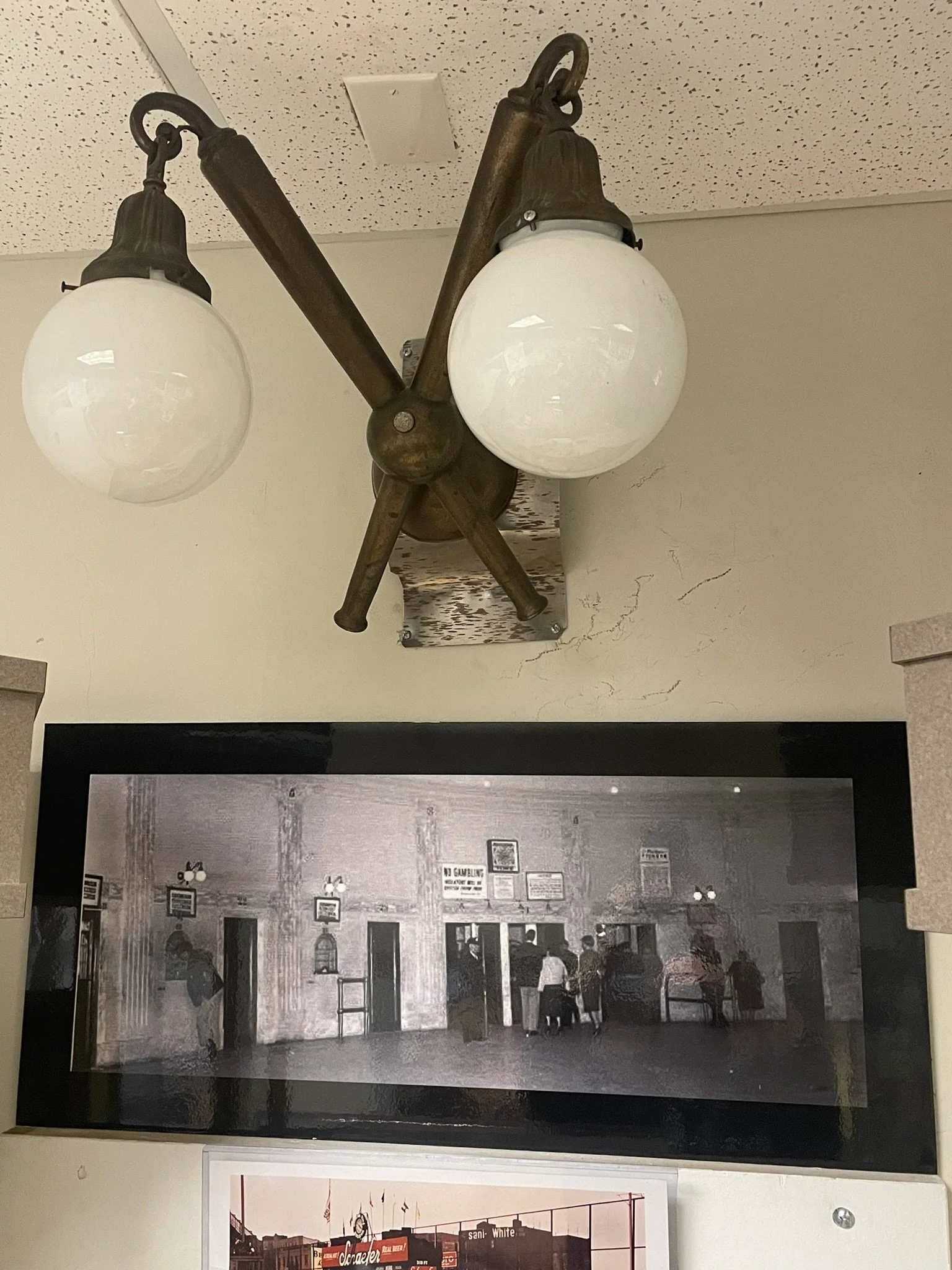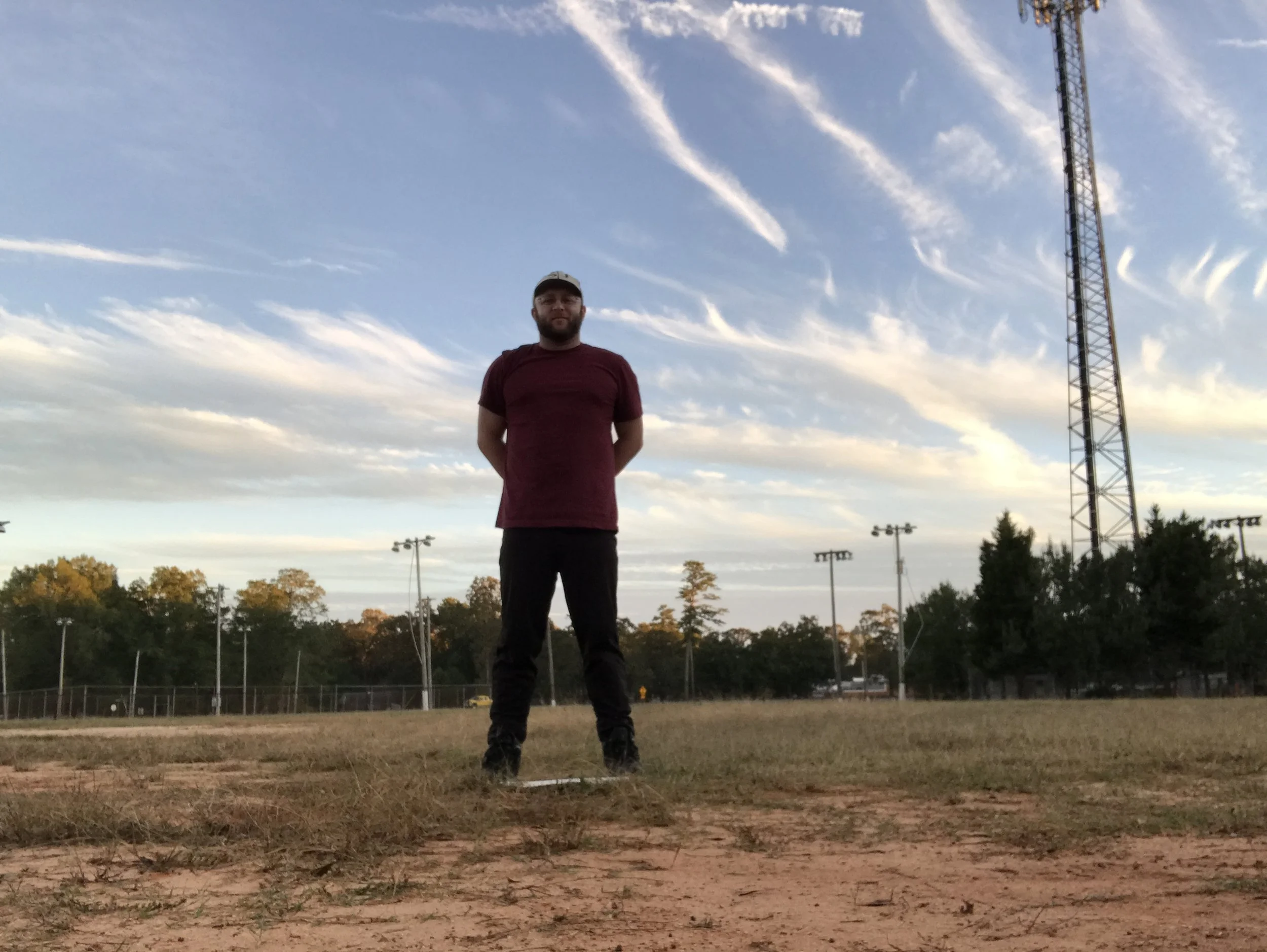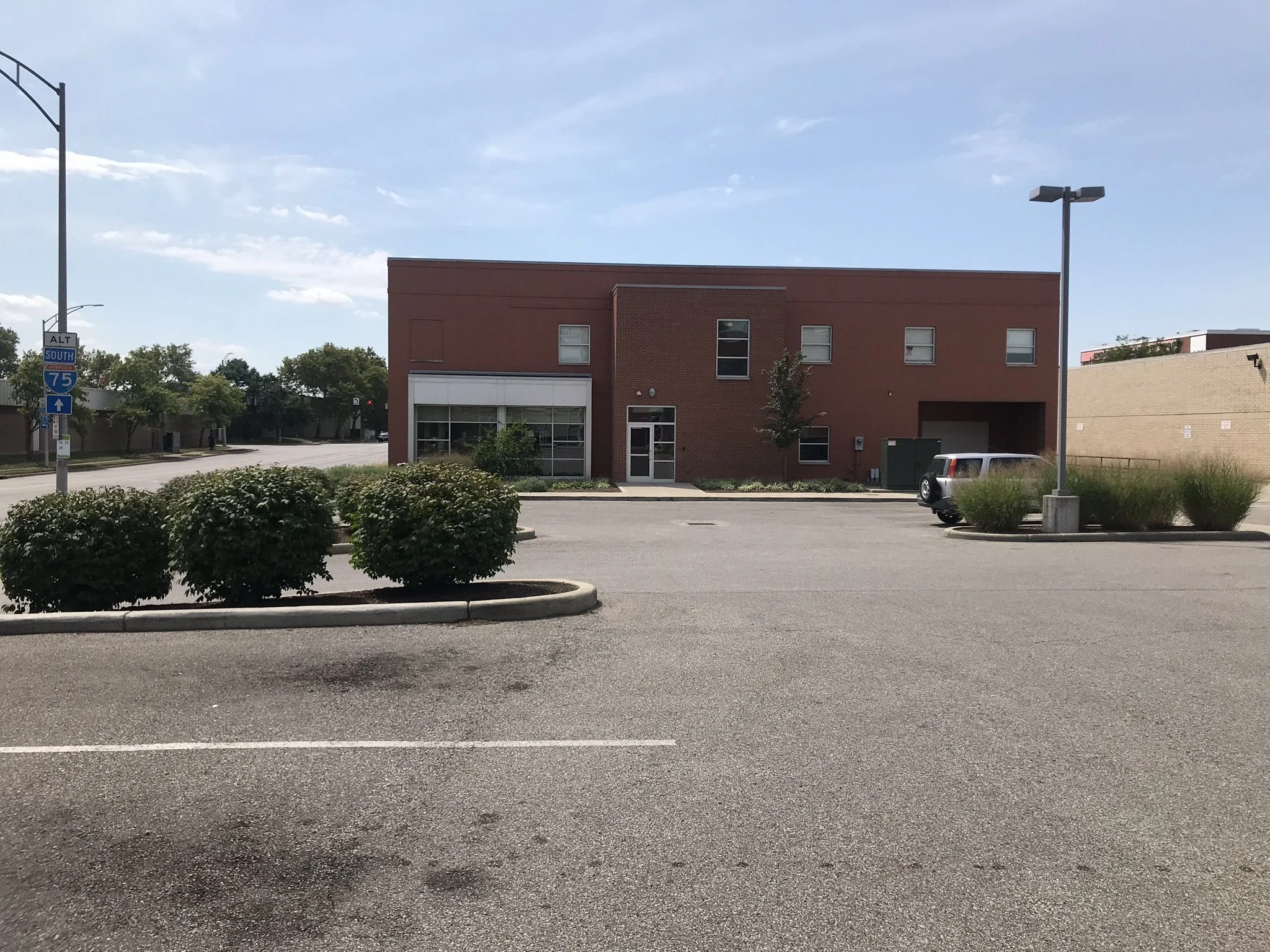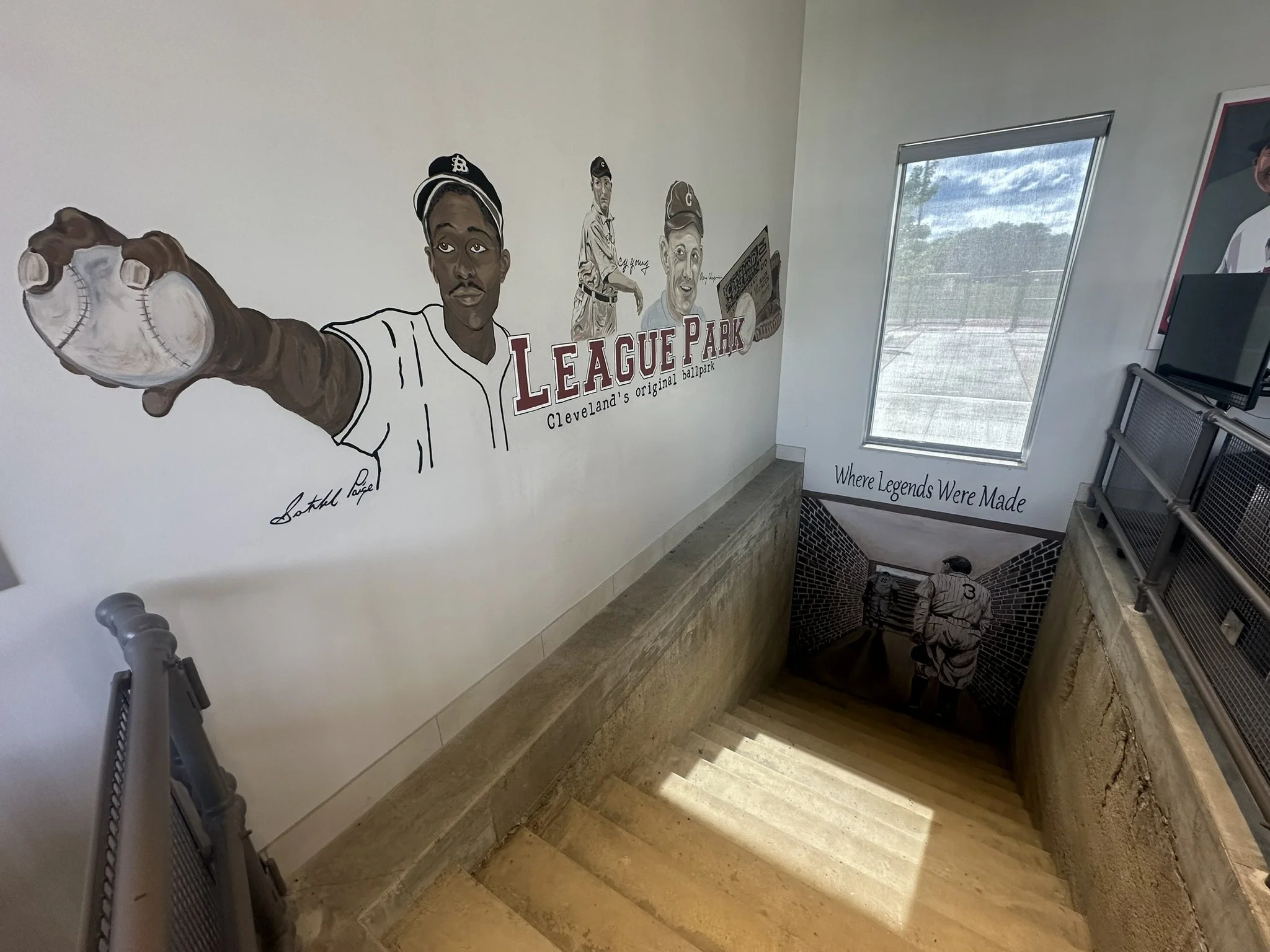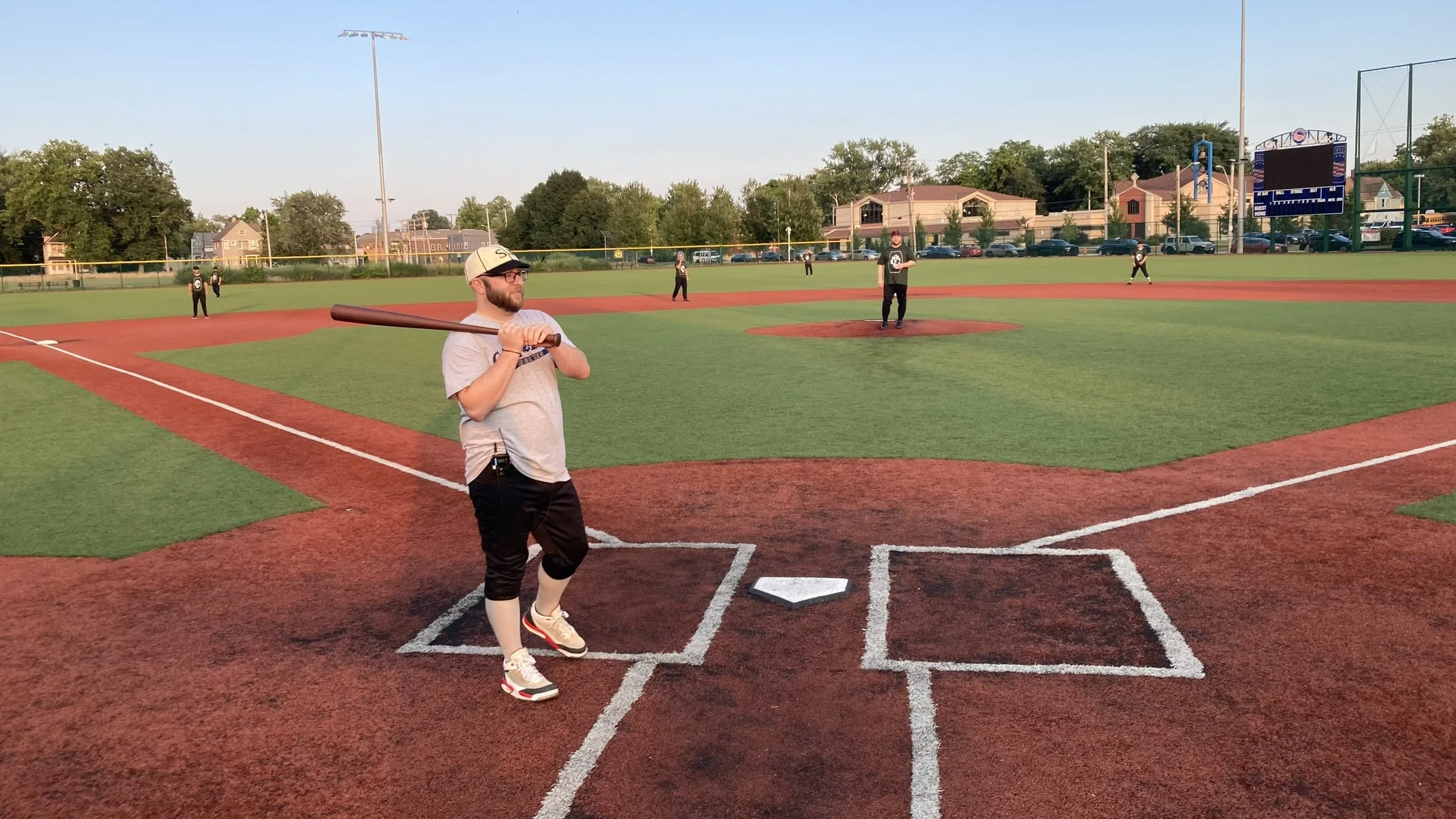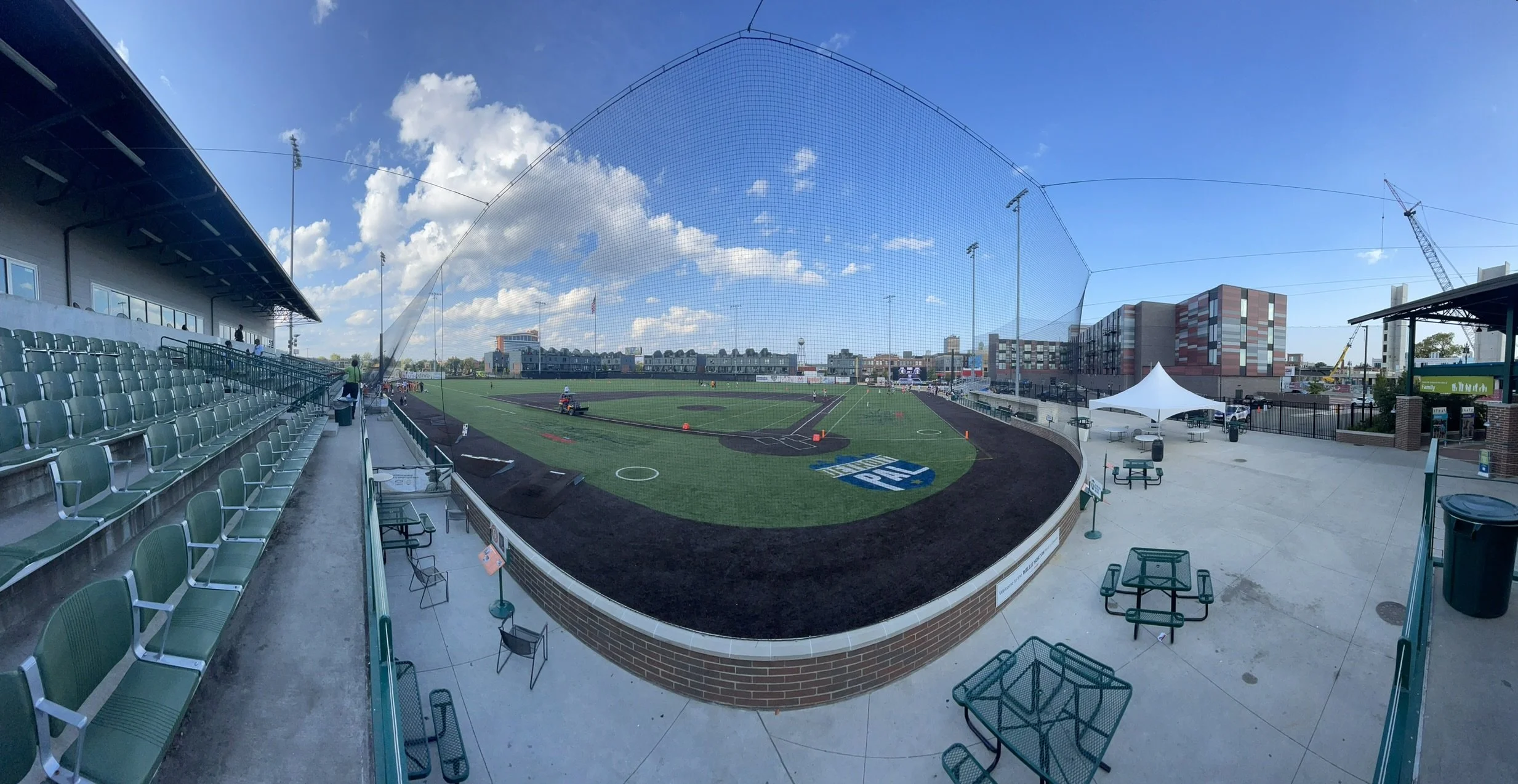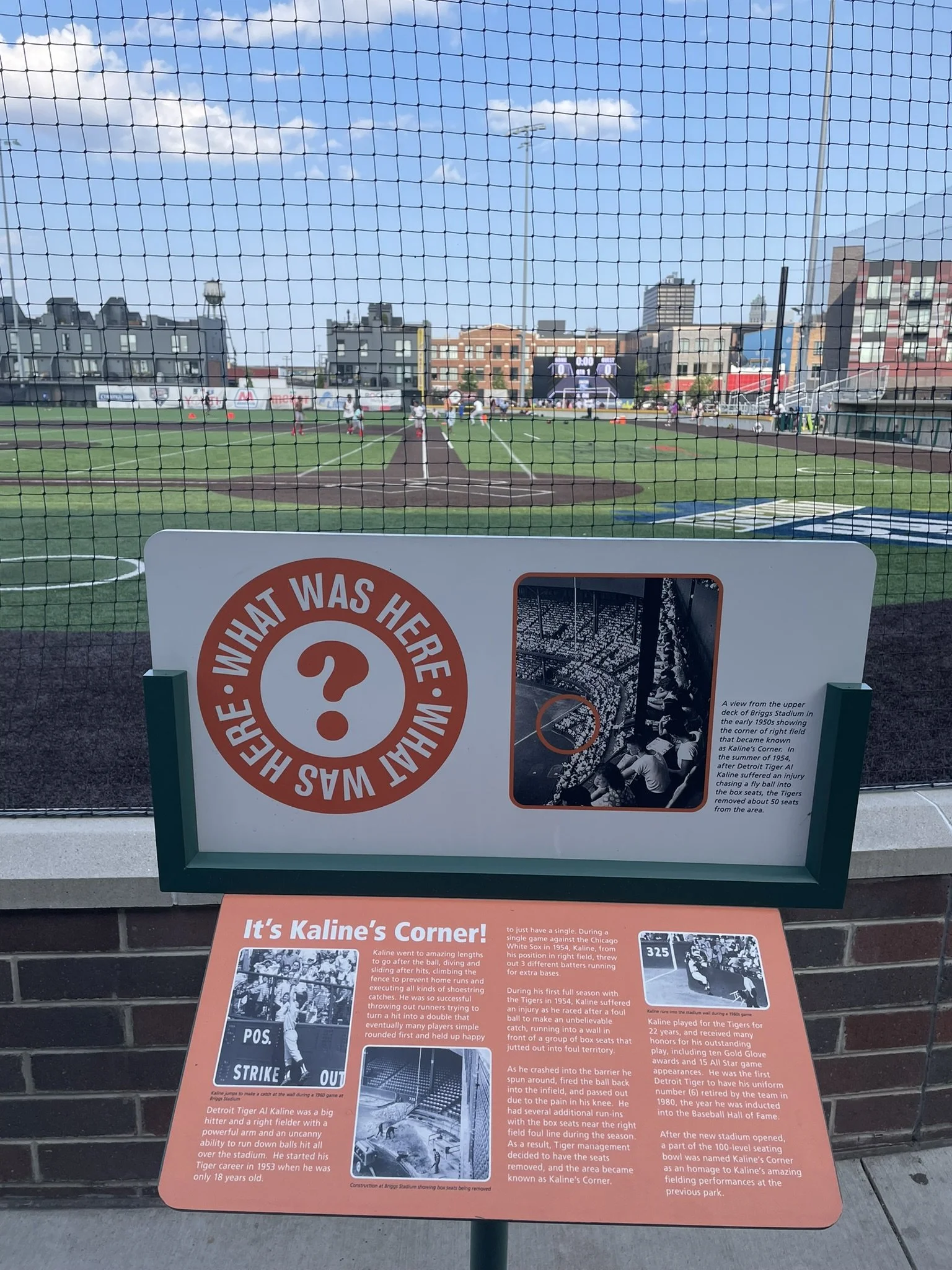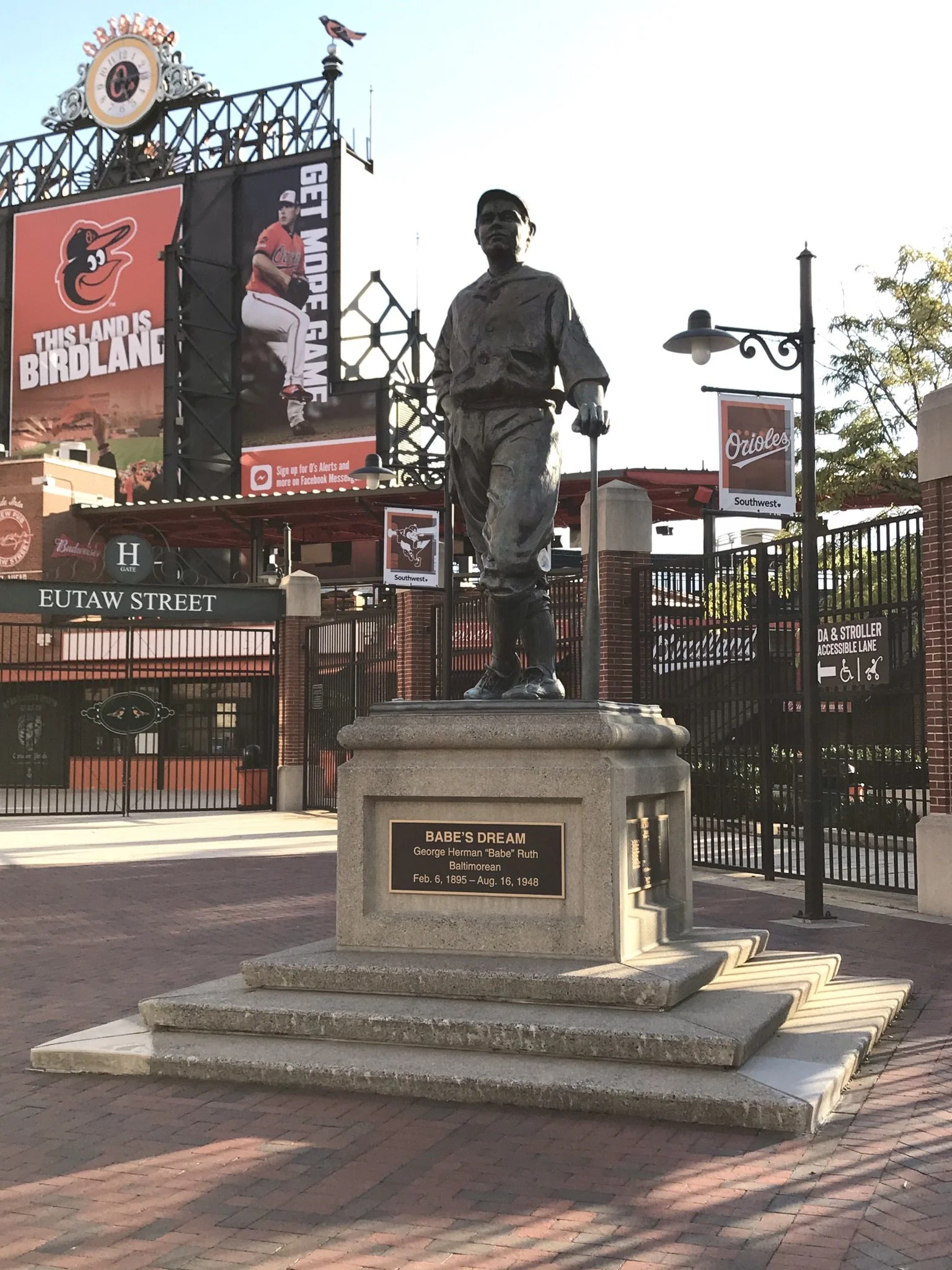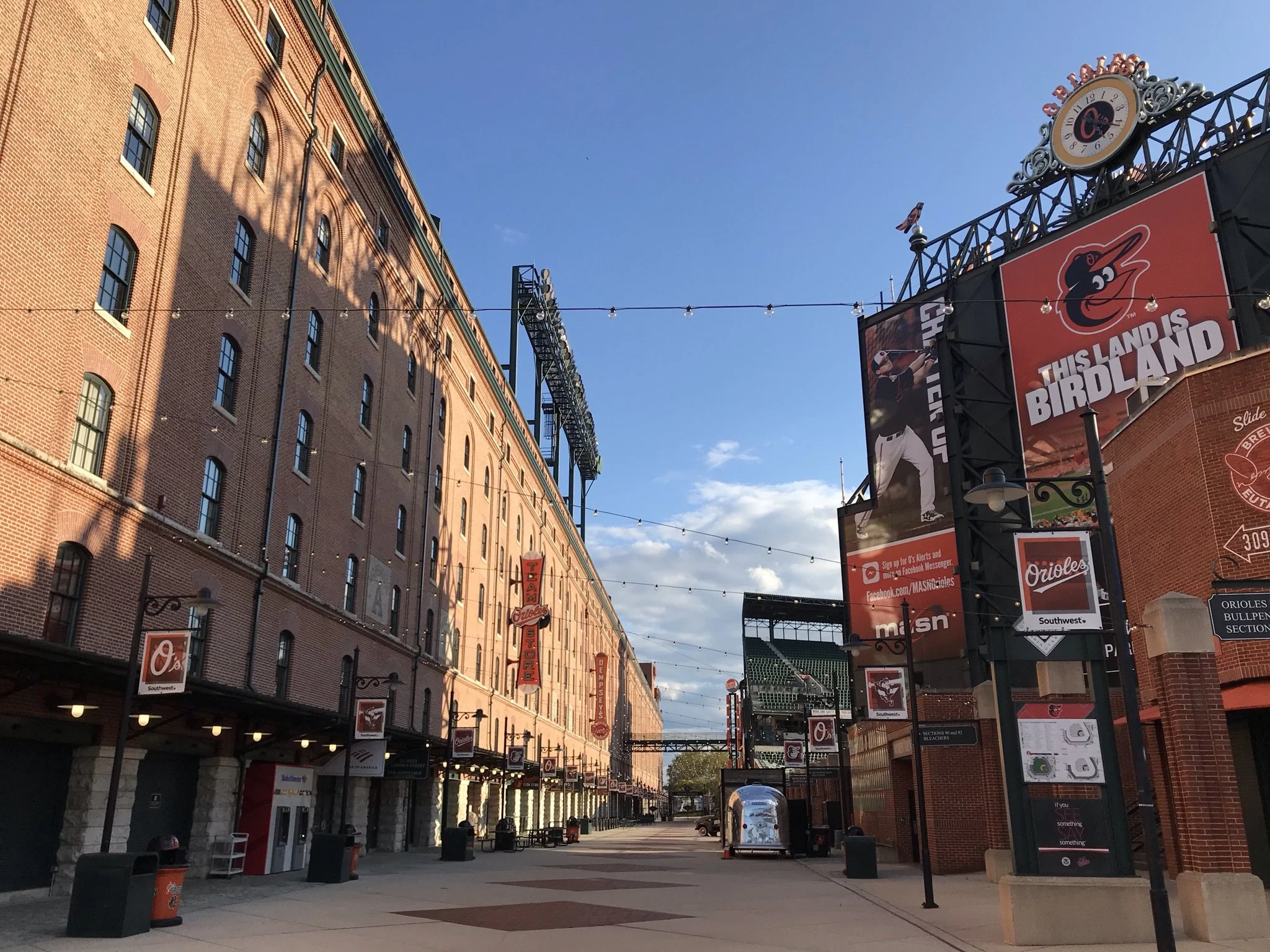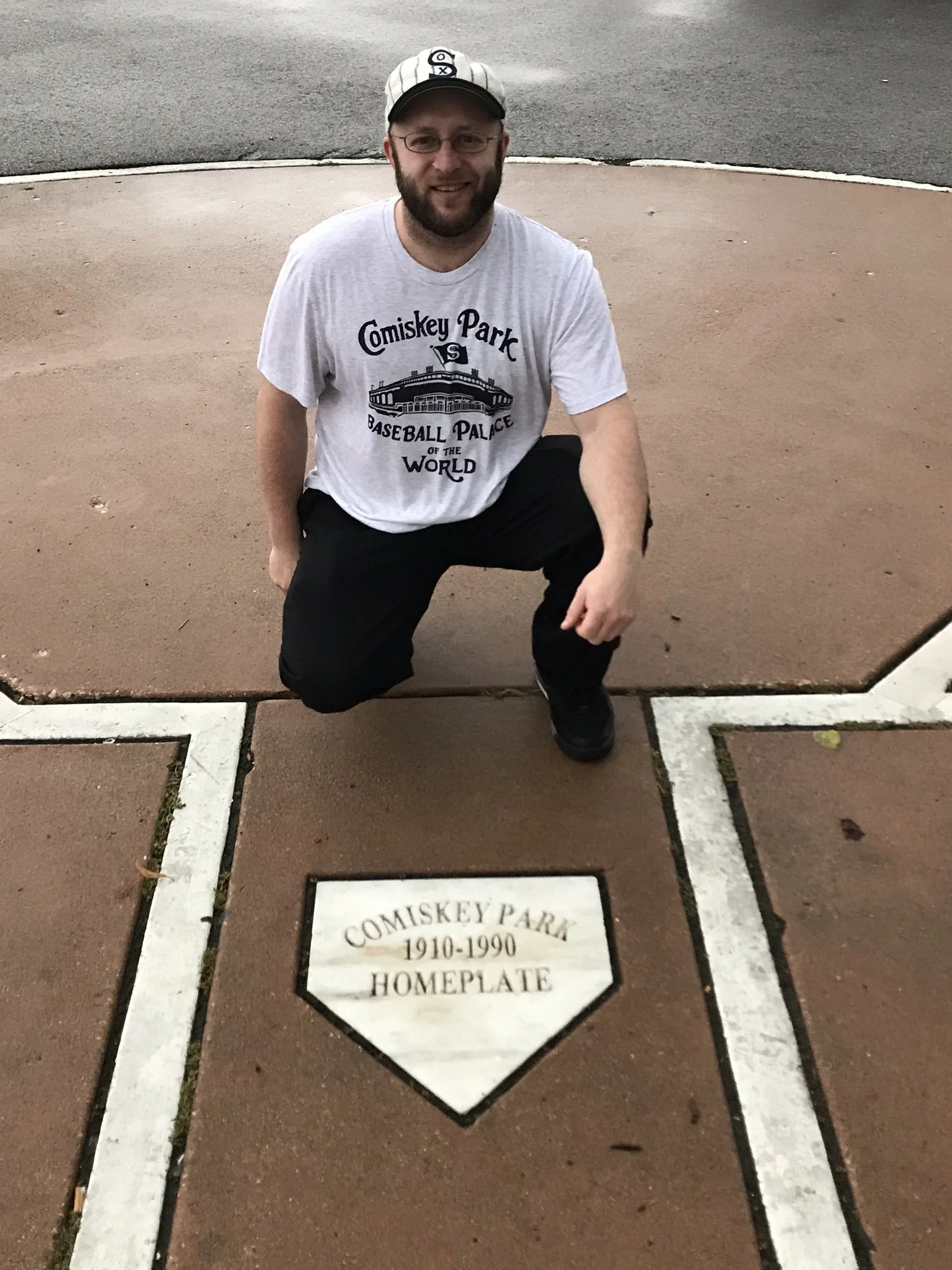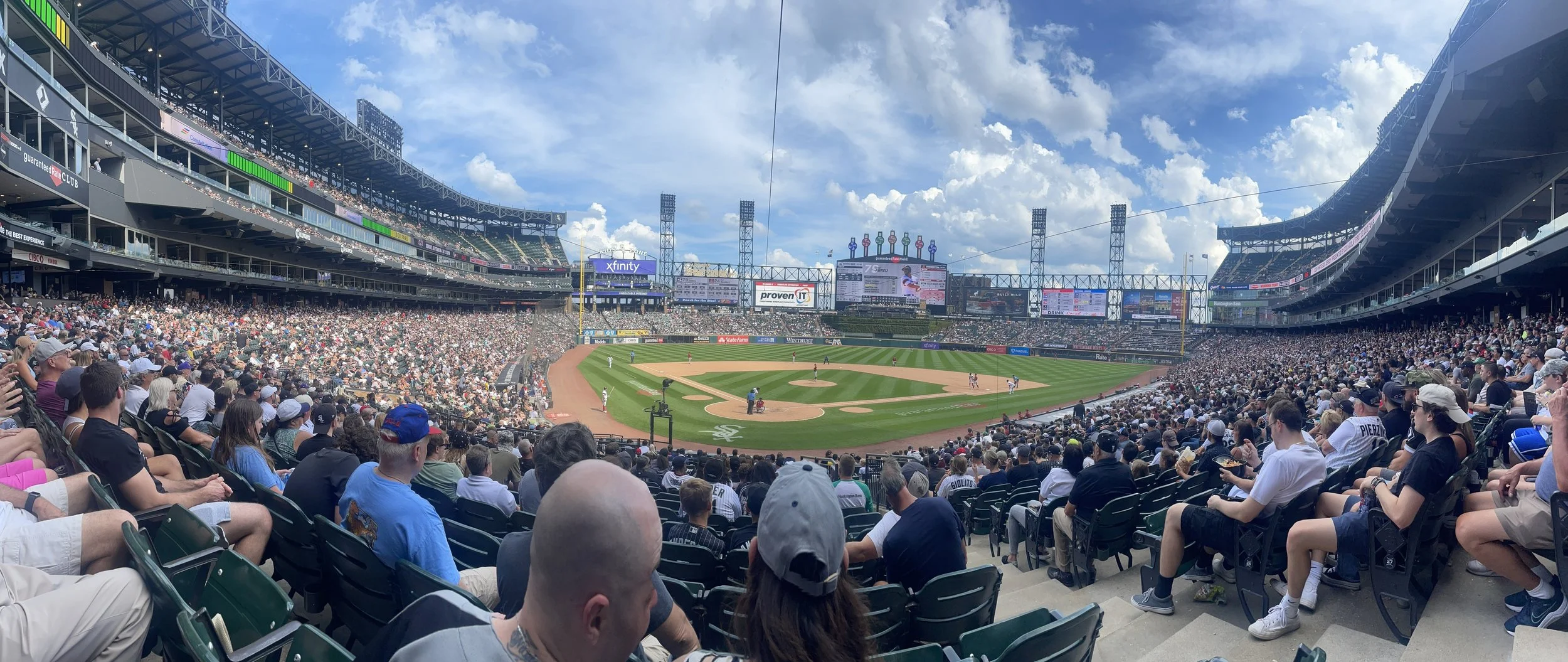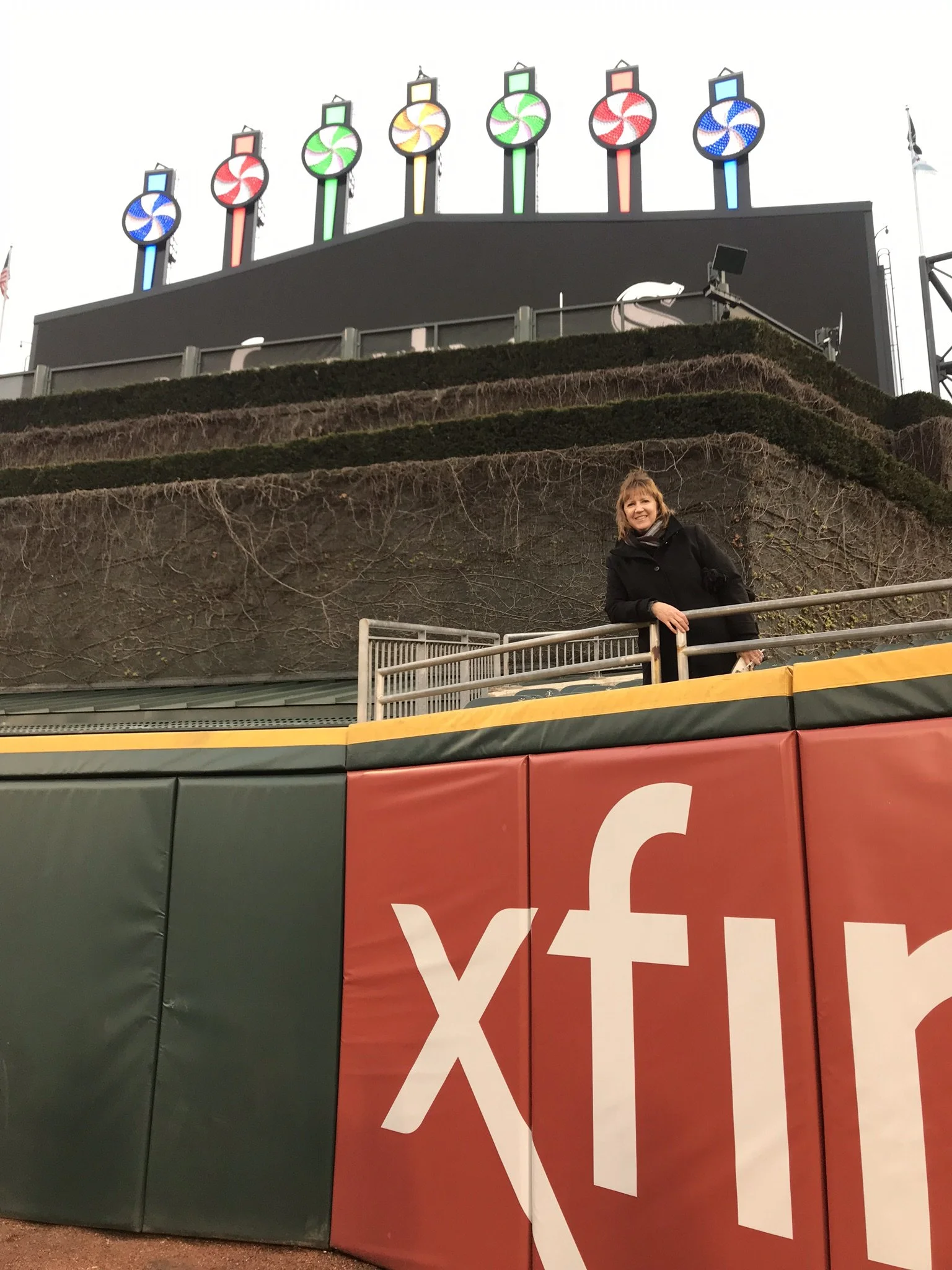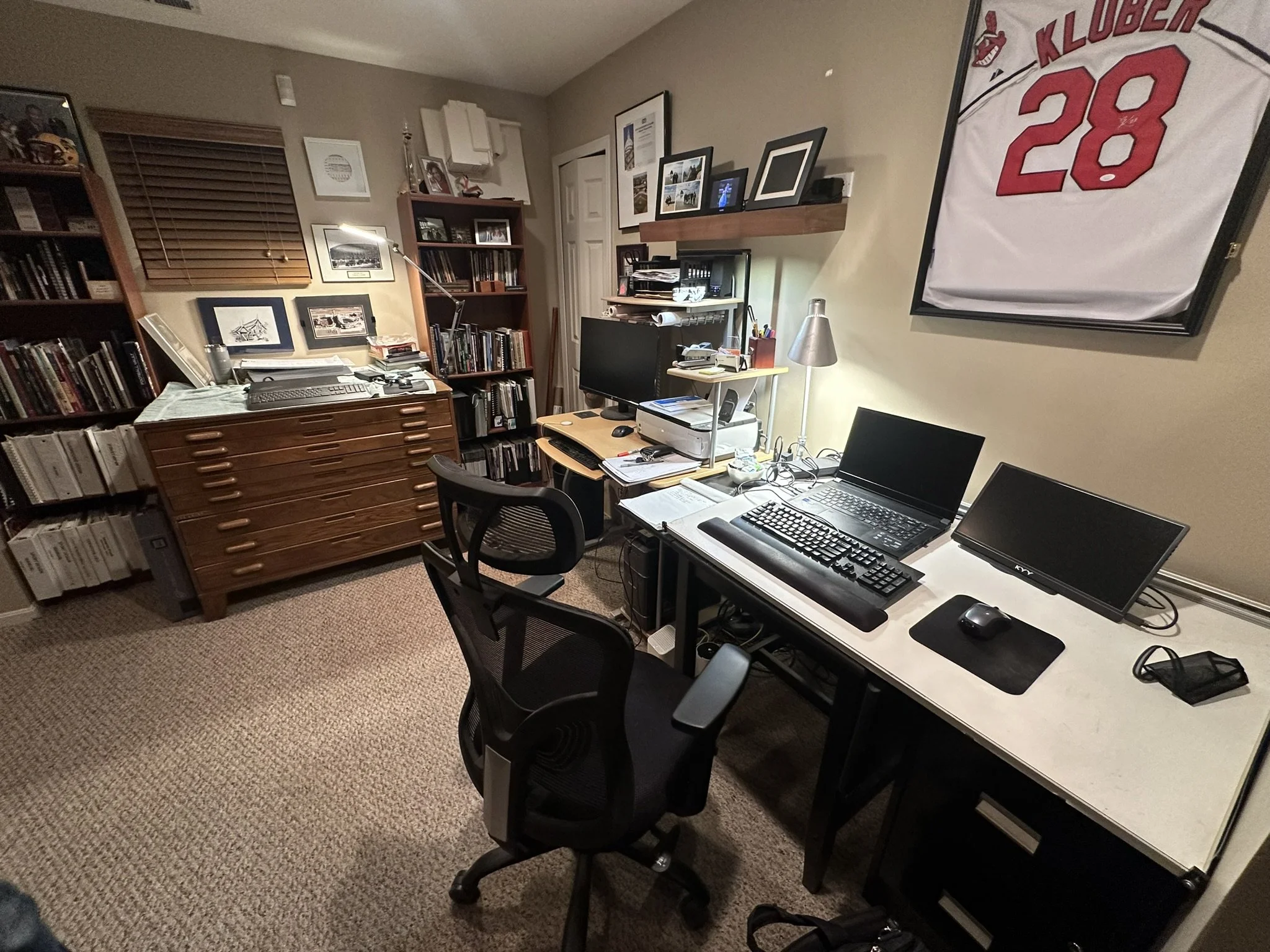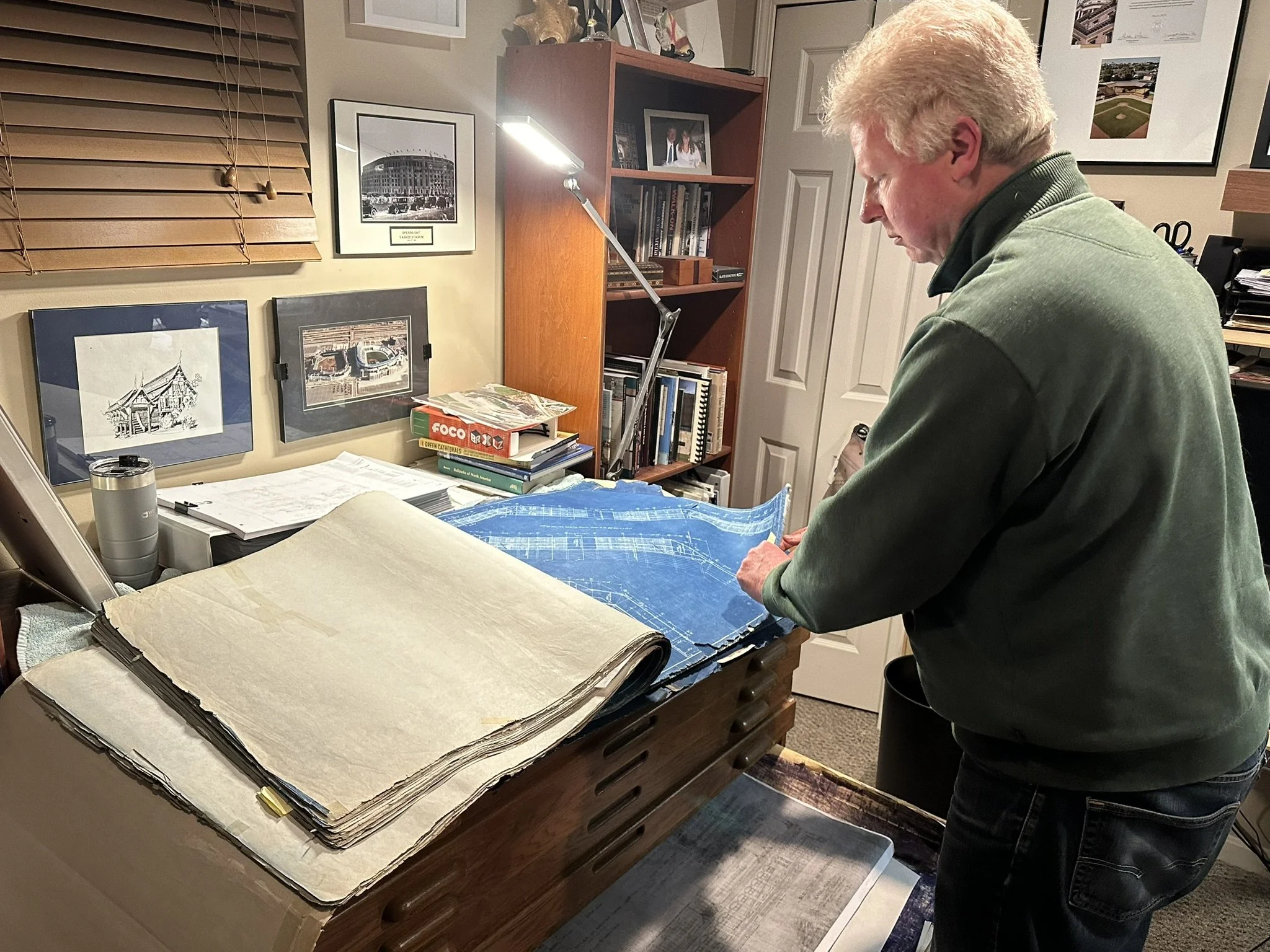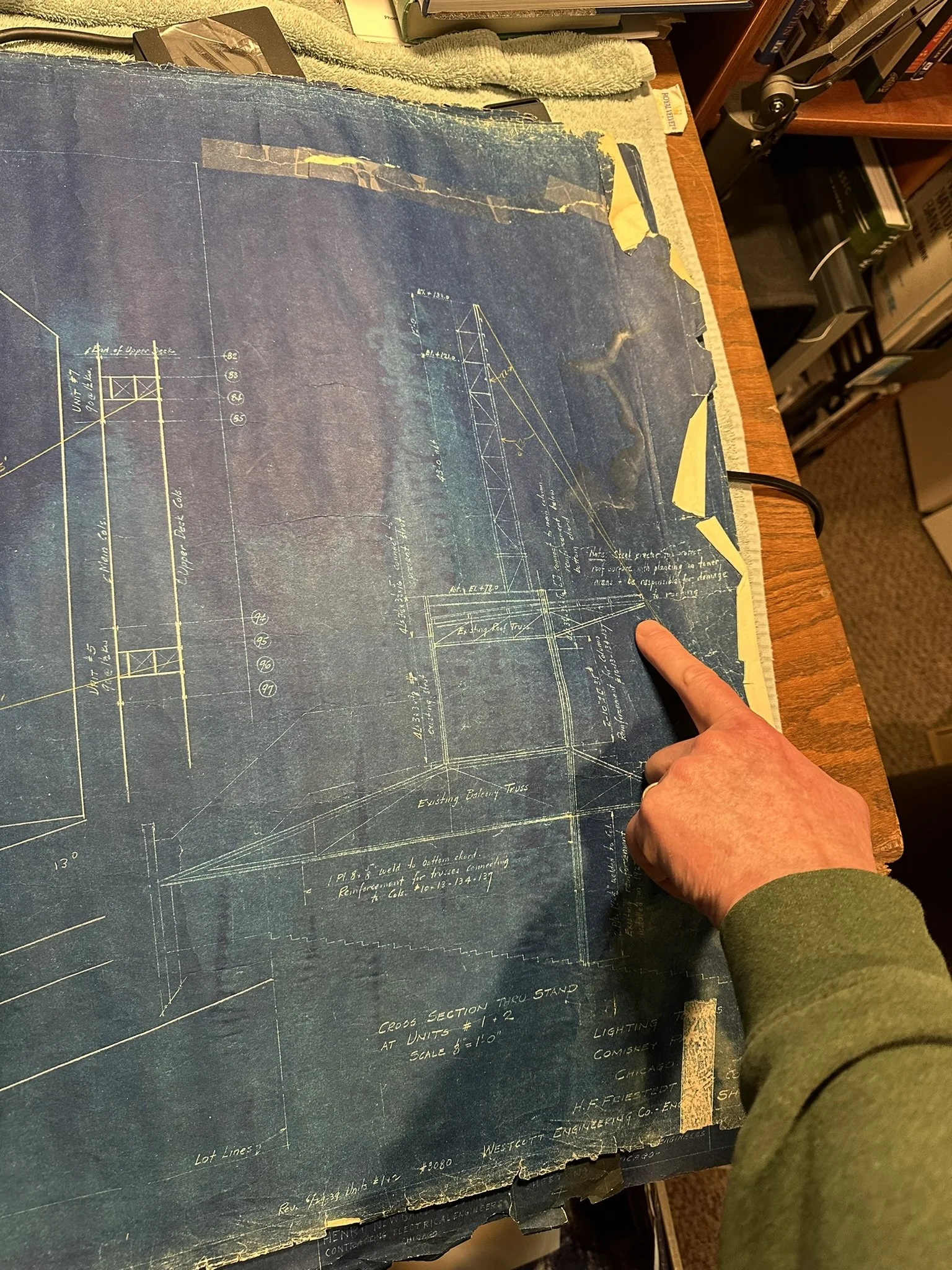0405 - Brian Powers
Brian Powers is a licensed architect and the man behind the incredible Bandbox Ballparks project which digitally reconstructs long-forgotten ballparks to preserve their histories. During our conversation, he referenced a handful of things and people upon which you may want to do more research. Consider this page to be your “liner notes” for the episode so you can follow along.
Me and Brian Powers in front of the legendary right field fence at Cleveland’s historic League Park.
The Glove Lab
This episode is brought to you by The Glove Lab.
Use code MBH15 at checkout to get 15% off their full-service package, which includes cleaning, conditioning, and re-lacing through the end of 2025.
Follow The Glove Lab on social media:
Watch these videos before you listen to the episode so you can see Brian’s work and understand what we’ll be discussing throughout the episode:
Okay, you get the idea? Pretty cool, isn’t it? Now on to the show…
Hohenecken Castle
Hohenecken Castle is the ruin of a spur castle from the Hohenstaufen era on the Schlossberg hill above the Kaiserslautern ward of Hohenecken in Rhineland-Palatinate, Germany.
Growing up a self-described “Army brat,” Brian spent time overseas, particularly in Germany. He remembers seeing this castle often as a kid, and becoming interested in architecture because of it.
My Foreign Exchange
This is the dome ceiling from one of the churches I visited while on a foreign exchange to Germany when I was in high school. It must have been one of the first churches we went inside because I was still interested enough (at 16 years old) to take pictures of it.
Neuschwanstein Castle
This is one of Brian’s original drawings he was talking about. It is of Neuschwanstein Castle, a 19th-century historicist palace on a rugged hill of the foothills of the Alps in the very south of Germany.
Brian drew this castle when he was either 8 or 9 years old.
Neuschwanstein Castle
In case you were wondering how accurate Brian’s drawing is, here’s an actual photograph of Neuschwanstein Castle.
Not too shabby for 9 years old, huh?
Municipal Stadium
Brian’s family members were baseball fanatics, which helped Brian develop a love for the sport. His grandfather would go to games at Cleveland’s Municipal Stadium, and was always interested in checking the box scores in the newspaper for attendance numbers in addition to the game stats.
Some games, the attendance was really, really good, considering the stadium held upwards of 80,000 fans. Other games, the attendance was … not as good.
Family
Brian’s dad, Rod, was stationed overseas for a portion of his military career. It was hard for Brian to keep up with baseball in a different country, though some games would be broadcast on the Armed Forces Radio and Television Service.
Scouts
Even though it may have been hard to follow baseball as closely as he may have wanted to, Brian took up other interests and stayed busy in other ways. When the Powers family moved back to the United States after Brian’s dad was transferred again, it became easier to watch, listen to, and attend baseball games.
Cleveland Indians Fan
Brian’s parents, his uncles, and his grandfather were all Cleveland Indians fans. When his classmates were wearing Yankees and Dodgers gear, Brian stayed strong, repping his hometown team. That’s a tradition Brian still participates in to this day.
What Is Lost?
As beautiful as new stadiums like Truist Park may be, it’s a shame to lose that connectivity between generations when stadiums are torn down and rebuilt every 30 years like seems to be the new trend.
Atlanta fans today aren’t going to games at the same stadium that their parents went to games, and their parents didn’t go to games at the same stadium that their parents went to games. There’s something sad about that.
Municipal Stadium
Brian remembers making trips as a child from Iowa to Cleveland to visit family. He knew they were close when he saw Chief Wahoo looking out over the freeway from Cleveland’s Municipal Stadium.
Seattle’s Kingdome
Brian’s family lived in Seattle for a while, shortly after the Kingdome opened. Brian remembers being fascinated with the architecture, specifically the sheer size a building needed to be to be able to play baseball inside of it.
This photo was taken on Opening Day of the 1985 season, Tuesday, April 9 against the Oakland Athletics.
Brian was enamored with the images of Fenway Park in the background of the closing credits of This Week In Baseball, as seen here after the episode which originally aired June 28, 1977.
Auburn University
Brian went to Auburn University and studied architecture. He chose Auburn because he wanted to go to a school which had both architecture and engineering programs.
Brian may be the only person I’ve interviewed for this podcast who knew what they wanted to do with their life after school, and then actually did that thing. It just goes to show you how driven Brian is.
Jordan-Hare Stadium
With the addition of the west upper deck in 1980 and the east upper deck in 1987, Auburn’s Jordan-Hare Stadium became the largest stadium in the state of Alabama.
Brian was a student at Auburn during its construction, and watching that process (along with a tour from Mr. Jackson Davis) solidified his desire to focus on architecture instead of engineering.
Trip To Chicago
In February of 1990, Brian’s architecture class took a trip to Chicago to see some buildings. One day, Brian decided he wanted to make a side trip to Old Comiskey Park, which was about to enter its final season as the home of the Chicago White Sox. He took this photo that day.
New Comiskey Park is being built in the foreground, with Old Comiskey still standing in the background.
Blueprints
Brian has amassed an incredibly impressive collection of blueprints over the last 35 years. Pictured here are some of his original blueprints from Old Comiskey Park.
League Park
When Brian became enamored with Old Comiskey Park after his trip to Chicago, he began learning about some of the other old ballparks from the past. League Park in Cleveland was a very early steel and concrete stadium, as well. Brian’s family ties to the city of Cleveland made that a special place for him, even though he had never seen a game there.
Shibe Park
The next ballpark Brian fell in love with was actually the first ballpark in the country to get the steel and concrete treatment: Shibe Park in Philadelphia, where the Athletics played from 1909 through the end of the 1954 season, after which they moved to Kansas City.
Rickwood Field
When Old Comiskey Park came down, Rickwood Field in Birmingham, Alabama became the next oldest ballpark in the country. Comiskey opened in July of 1910, while Rickwood opened in August. Fenway Park, the current oldest Major League ballpark, didn’t open until April of 1912.
Here, Birmingham Barons ballplayers and fans pose in front of Rickwood’s distinctive entrance in 1930.
A Thorn In Birmingham’s Side
After the Birmingham Barons moved to Hoover Metropolitan Stadium for the 1988 season (where they would play their home games through the end of the 2012 season), Rickwood Field sat abandoned and was left to decay.
The city of Birmingham didn’t really know what to do with it, so it mostly just sat, untouched, with no tenants. It seemed destined for the wrecking ball.
Historic American Buildings Survey
The Historic American Buildings Survey (HABS) is the nation's first federal preservation program, begun in 1933. As such, it established methodologies that are now standard practice within the field such as the surveying and listing of historic sites and the creation of documentation for public benefit.
A HABS team came to Rickwood Field to preserve its history. Images from the HABS report can be found HERE.
One of the images of Rickwood Field included in the HABS report.
Friends of Rickwood Field
Brian was living in Montgomery, Alabama at the time, but he routinely made the 180-mile round trip back and forth to Birmingham to watch the HABS team work, and learn how to preserve a historic ballpark.
Brian became one of the charter members of the Friends of Rickwood Field, which formed in 1992.
MLB At Rickwood
On June 20, 2024, the San Francisco Giants played the St. Louis Cardinals in a regular season MLB game at Rickwood Field.
Three decades earlier, no one involved in saving Rickwood could have envisioned a Major League game taking place at that location. Brian included.
Filming Cobb
While the Friends of Rickwood and the HABS team were working on saving the field, some Hollywood scouts were in the area and thought Rickwood would be the perfect setting for some of the games to be filmed in the upcoming movie Cobb.
They agreed to help pay for the renovations, as long as they could film in the newly-renovated stadium once it was complete.
Vacant No More
Once the field was renovated for the movie, the city of Birmingham and its residents starting using Rickwood much more frequently. The Barons would play “turn back the clock” games there occasionally, high school teams would play there, and community events and charity games would be held at the historic space.
In 1993, it may have been impossible for Brian to look ahead and envision professional baseball happening at Rickwood again. But, as an architect, he was able to look back and imagine what it must have been like in its former glory, as seen here in 1929 with a capacity crowd. (Photo courtesy of Glynn West)
More Than Just Baseball
Rickwood Field played an important role in the community, above and beyond hosting baseball games.
On August 18, 1915 the Alabama Equal Suffrage Association and the Birmingham Barons hosted a suffrage day to support women’s suffrage during a baseball game at Rickwood. Just a few years later, the women of Alabama, as well as women across the United States, were granted the right to vote after the passage and subsequent ratification of the 19th Amendment to the U.S. Constitution.
Rickwood also played a role in the Civil Rights Movement, proving to community members that people of different races could coexist.
Rickwood in 2016
Seeing the transformation just from 2016 (my first time at Rickwood Field) to 2024 (when I was there for the MLB game between the Giants and Cardinals) was impressive enough.
I can’t even imagine how proud Brian must be to have seen the transformation from 1993 to 2024.
Tom Paciorek
Left fielder Tom Paciorek emerged as an offensive leader for the Mariners in 1981, finishing second in the AL batting race (.326) to Carney Lansford. Tom was also in the top ten in the league in on-base pct., slugging pct. and OPS.
Paciorek hit game-winning, game-ending (this was before the term “walk off”) home runs in back-to-back games against the Yankees at the Kingdome May 8th and 9th. The second game-winner thrilled a Bat Night crowd of 51,903, of which Brian was one.
Amazing Events
Brian has been to All-Star Games, Home Run Derbies, and has seen a lot of great stars play the game in person. But often the memories he takes back from a certain ballpark or event are tied into his experience, not necessarily who he saw play.
Angel Stadium of Anaheim
Angel Stadium is the fourth-oldest ballpark in the Majors, as it debuted in 1966 after the club moved from Los Angeles and became the then-California Angels. Brian’s first big project was working on major renovations to the stadium which took place in 1997 when the club was under Disney ownership.
Gene Autry and Babe
Maybe the Babe in this photo is Babe Herman and not George Herman Ruth, but I couldn’t find a picture of Gene Autry and Babe Ruth together, okay? This is pretty close, though, huh? And no, your eyes haven’t deceived you. Gene and Babe swapped their regular uniforms for this picture.
New Comiskey Park
Brian said that when New Comiskey Park opened, there were “mixed reviews” on it, which is putting it extremely nicely.
Janet Marie Smith
“There is only one Janet Marie Smith,” said Rob Neyer, a baseball author, analyst and commentator. “She is a devotee of writer Jane Jacobs, who wrote about the life of a city and what it should be for its people. And that’s a big part of what (Smith) does. In some places, they have tried to put these ‘retro-style’ ballparks in the suburbs, but if you don’t do it in a city, it’s not the same.”
Oriole Park at Camden Yards
The Baltimore & Ohio Warehouse is adjacent to Oriole Park at Camden Yards. It was constructed by the Baltimore and Ohio Railroad (B&O) beginning in 1899, with later sections completed in 1905. It is purported to be the longest brick building on the East Coast.
When Janet Marie Smith and company were making Oriole Park the first “retro modern” ballpark, they tried to figure out a way to incorporate the warehouse into the ballpark experience. It worked.
Indoor Venues
There are facebook groups (such as Ballpark Chasers) with tens of thousands of members who all share the same goal of trying to see a game at every MLB stadium. Those groups don’t really exist for other sports with the same passion as they do for baseball. It’s a challenge to give an indoor venue its own personality, but that doesn’t mean it can’t be done.
Here is Brian at the United Center, which has been the basketball home of the Chicago Bulls and the hockey home of the Chicago Blackhawks since 1994.
Wrigley Field
The new trend seems to be teams wanting to own as many properties around their stadium as possible, so they can have restaurants, hotels, bars, and shops as added revenue streams in addition to the money they make from parking, ticket sales, and merchandise and concessions inside the stadium.
Teams also want to use their stadiums as many days out of the year as possible, whether that be by hosting sports other than the one normally played in the stadium, concerts, private events, political rallies, or anything else. An empty stadium doesn’t make the owner money, and making money is the true name of the game.
Hamtramck Stadium
Historic Hamtramck Stadium was dedicated in 1930 and served as the home of the Detroit Stars and the Detroit Wolves of the Negro Leagues. As many as 17 future Baseball Hall of Famers played there over the years.
As one the few remaining Negro League ballparks in the United States, Hamtramck stadium was recognized on the National Register of Historic Places in 2012.
Photo courtesy of Hamtramck Heritage Collection
Historic Structures Report
Hamtramck was awarded the African American Civil Rights Grant to complete pre-development planning for Hamtramck Stadium, and in 2018, as part of the planning project, Brian were tasked to complete a Historic Structures Report and create a conceptual vision for the stadium and grounds to serve the community into the future.
Read the Historic Structures Report HERE.
Historical Significance
A big part of the HSR is demonstrating a site’s historical significance. Luckily, Hamtramck Stadium has a storied history, with as many as 17 Hall of Famers having played there at some point over the years.
Photo courtesy of Hamtramck Heritage Collection
Conceptual Design
The State Historic Preservation Office (SHPO) has strict criteria in place so developers can’t come in and just start doing their own thing in a space which is designated as a historic structure. You have to be very sensitive to the historical aspects of the property.
Before And After
Brian worked closely with Wayne County to rehabilitate the existing grandstand structure, including the roof, wood seating deck, bleachers and steel super structure to its original 1930s look as a part of the centennial celebration of the 100-year anniversary of the Negro Leagues in 2020.
Photo courtesy of Colin Winterbottom
I visited Hamtramck Stadium on the evening of June 5 and the morning of June 6, 2022.
The murals everywhere made the stadium feel very much like a community gathering place. Like it was for everyone, not some place you could only go if you paid admission.
Norman “Turkey” Stearnes is one of the (at least) 17 Hall of Famers to have played at Hamtramck over the years. Stearnes was most known for his time with the Detroit Stars, who called Hamtramck home at points during his career.
Rewarding Work
Brian’s rehabilitation work on Hamtramck was awarded the prestigious Michigan Governor’s Award from the State Historic Preservation Office in 2023, but he said the thing that makes him most emotional about the project is knowing that kids and the community can use that field for generations to come, when it had been derelict for decades.
Bandbox Ballparks
In 2019, Brian formed Bandbox Ballparks to share his specialized research of our sports architectural heritage, aiming to tell the stories and preserve the architectural legacy of sports venues today to be enjoyed by generations of tomorrow.
Ink On Vellum
When Brian first started working as an architect, the tools of the trade were still ink on vellum with a parallel bar.
AutoCAD
After vellum, things progressed to AutoCAD. Researched drawings, photos, and sketches help to develop full CAD drawings of the entire ballpark. The level of detail meets Historic American Building Survey standards.
It would have been hard to imagine how far the technology has come in just three decades.
Building Information Modeling
In the mid-2000s, there was a large leap in Building Information Modeling (BIM), which is a digital representation of physical and functional characteristics of a facility. A BIM is a shared knowledge resource for information about a facility forming a reliable basis for decisions during its life-cycle, from earliest conception to demolition.
HABS Standards
The old Comiskey Park Revit model allows generation of high-quality drawings to Historic American Buildings Survey (HABS) standards, which means Brian could submit these drawings to the Library Of Congress for inclusion to preserve them. This section of Comiskey Park is cut through the RF Pavilion.
Shoe Shine
The fusion point of all smells at old Comiskey Park. Brats, beer, cigarettes and shoe polish swirled together with a light draft of infield grass from the 3rd base entry portal.
Why Comiskey?
Brian’s visit to Comiskey Park in March of 1991. There was still one season left to play, but its days were numbered. Thus began a 28-year odyssey for Brian to preserve the park as he amassed a large collection of photos, drawings, books, and maps.
Osborn Engineering
Osborn Engineering is an architectural and engineering firm based in Cleveland. Founded in 1892, it is noted mostly for designing sports stadiums. More than 100 stadiums have been designed by Osborn, including Fenway Park, the original Yankee Stadium, Tiger Stadium, and numerous minor league, collegiate, and major league sports facilities in all sports.
Frank Osborn is pictured here.
Osborn Blueprints
Brian is lucky enough to have a complete set of Osborn Engineering blueprints from Cleveland’s League Park in his personal collection.
Original Ticket Office
Brian mentioned that of all of the ballparks he’s done, League Park is the one which still has original components you can go visit.
The original ticket office at the corner of 66th and Lexington in the Hough neighborhood is still standing, and houses the Baseball Heritage Museum.
Ticket Office
Here is Brian’s rendition of what that original ticket office looked like at League Park.
Player Tunnel
These steps were originally between the home and away clubhouses and took the players through a tunnel under the grandstand so they could get to their respective dugouts.
While the tunnel has been filled in for safety reasons, the steps are still there.
Steps
Here is Brian’s rendition of what those steps looked like at League Park.
Hough Neighborhood
Brian wonders what the Hough neighborhood may have looked like when League Park was in its hey day. While there aren’t too many pictures from that era, we do have the Hopkins Plat Book Of Cleveland map from 1912 which shows us what businesses and homes surrounded the stadium.
Brian’s Version
Brian made the Hough neighborhood come to life a little bit more with his rendition.
Blueprints Or Bust
While photographs and images like the one seen on this 1910 postcard of League Park may be helpful to color the ballpark (literally and figuratively) once the model is made, there would be no way for Brian to accurately make a model without a full set of the actual blueprints. There is no guessing in Brian’s work. Every inch is exactly as it would have been originally constructed.
Specific Entrances
League Park was unique in that there were specific entrances for each section, so depending on where your ticket was for, that’s how you entered the ballpark initially. You couldn’t go through the wrong turnstile because the ticket taker at that turnstile would see you didn’t have a ticket for that section.
Specific Pathways
Then, once you were inside the stadium, the only place you could go was to your section because there were fences and guided rails and pathways which led you only to where you were supposed to be.
The Colosseum
The Colosseum is an elliptical amphitheatre in the center of the city of Rome in Italy, just east of the Roman Forum. It is the largest ancient amphitheatre ever built, and is still the largest standing amphitheatre in the world, despite its age.
Some experts estimate that it took only 15 minutes for more than 50,000 spectators to empty the Colosseum. The vast corridors, or vomitorium, allowed for quick flow of the traffic, and crowds spilled out in a matter of minutes.
Huntington Avenue Grounds
Longtime listeners of My Baseball History may remember us mentioning the Huntington Avenue Grounds in Boston during our episode with William Peebles, owner of Huntington Base Ball Co., who hand makes base balls and all sorts of other great pieces. You can listen to that episode HERE, where we discuss the history of the ball used to play the sport, and how they have been made throughout time.
The Grounds was the first home field for the Boston Red Sox from 1901 to 1911.
Columbia Park
Columbia Park in Philadelphia was home to the Athletics from 1901 through 1908. The team felt by the middle of 1902 that they had already outgrown the park, and nearly immediately started looking for a new location where they could build. It wasn’t until 1909 when Shibe Park opened and the team moved.
Listen to our episode with Alex Cheremeteff on the history of the Philadelphia Athletics HERE.
Harry Hake
Harry Hake Sr. (1871 - 1955) was a prominent American architect in Cincinnati at the turn of the 20th century. His son Harry Hake Jr. and grandson Harry Hake III were also prominent architects and partners in his firm. The Hake family were the architects responsible for Crosley Field and all of its remodels and renovations over the years.
Sacred Ground Exhibit
The Sacred Ground exhibit at the National Baseball Hall of Fame in Cooperstown celebrated the special connection people feel in their favorite ballpark. The exhibit used sights, sounds, and even smells to remind fans of their favorite ballparks.
It featured more than 200 artifacts and interactive displays spanning 125 years of baseball history and culture, and took up 1,800 square feet on the museum’s third floor.
Lenny DiFranza
Lenny DiFranza was the Assistant Curator of New Media at the National Baseball Hall of Fame and Museum when Brian learned the Hall had acquired some original blueprints of Old Comiskey Park from 1910.
Brian and Lenny struck a deal that each party would share what they have with the other, so both Brian and the HOF had full sets of Comiskey’s prints. Eventually this led to Brian’s work being part of the Sacred Ground exhibit.
Gaining Credibility
As if Brian’s work doesn’t speak for itself, the fact that it has been major parts of exhibits at the Hall of Fame in Cooperstown and the Baseball Heritage Museum at Cleveland’s historic League Park lends Brian even more credibility.
Brian’s philosophy is “if you do good work, it will get noticed.” He has definitely been noticed.
Shibe Park
Brian would love to be able to digitally recreate Philadelphia’s Shibe Park, but he just can’t find sufficient blueprints to do the job to the standards he holds himself to.
If you have any blueprints, or can help Brian find some, please let one of us know.
Connie Mack’s Office
Connie Mack’s “oval office” was in the corner tower of Shibe Park and its domed cupola. This allowed Mr. Mack the ability to have 360 degree views to the exterior of the stadium, and onto the playing field, without leaving his office.
“The Tall Tactician” sits at his desk at the ripe old age of 87 in this 1949 photo.
The Polo Grounds
The other park Brian wants to do but just can’t find sufficient blueprints for is the Polo Grounds in New York. So many quirks, so much history, it would be amazing to see Brian’s interpretation of it. Maybe one day…
SABR article on the Polo Grounds by former My Baseball History guest Stew Thornley
Perks Of The Job
One of Brian’s favorite things now that his work is well known is having people send him interesting photographs of different parts of forgotten stadiums and ballparks.
Players used to have to walk all the way across the field at the Polo Grounds and up a staircase in deep center field to get to their clubhouse. Imagine a stadium getting built like that today!
Visually Accurate
Not just in the placement of features, but with their colors, as well. It took Brian a couple different attempts to get the color of the seats at Ebbets Field to show up as the perfect shade of blue.
Specification
Sometimes Brian gets lucky and can find the specification of a ballpark’s finish schedule, which is a companion to the blueprints which sometimes describes the colors of seats, railings, lockers, and other features of the ballpark.
He has this one of Cleveland’s League Park from August of 1909, prepared by the Osborn Engineering Company.
Historic Photos
Historic photos like this one of Kid Gleason at Comiskey Park in 1919 are great in showing where seats and railings and other architectural details were exactly placed, but if a photo is in black and white, it can only help Brian so much. From there, he needs to do the research to find out what color those seats were, what color those railings were, etc.
Photo courtesy of the Chicago Sun-Times/Chicago Daily News collection, Chicago History Museum
Historical Accuracy
Sometimes the easiest way to make sure you’re getting the colors right is to simply find an artifact which has survived in its original condition.
Luckily for Brian, the Baseball Heritage Museum at League Park has a handful of different seats from throughout the stadium, all painted their original colors.
The Seats Tell A Story
Sometimes, if Brian gets lucky, he’ll find a seat from a stadium with multiple layers of paint on it. Some seats from Comiskey Park, for example, have three different colors of paint on them from throughout the years, as they were originally painted red, then covered in sky blue paint (seen here), and finally finished with green paint on top of that.
Those little details tell the story of a ballpark, and bridge the gap from era to era.
Seat Study
Brian painstakingly diagrammed the seats from Comiskey Park so when it came time to input the dimensions into his program, everything would be exactly as it would have appeared in real life.
Ticket Look Up
Brian can often tell just based on the size and shape of a seat where in the ballpark it would have been. But another cool way he can use his models is by looking up exact seat locations based on ticket stubs. Like this one, for example, from Section 40, Row A, Seat 22 at Ebbets Field.
Section 40, Row A, Seat 22
With his model, Brian can find that exact seat in Ebbets Field, and show you what your view from that seat would have looked like if you were really sitting there.
American Seating Company
Not all blueprints show the exact designs of the seats in the stadium, or the exact locations of those seats within each section. But Harry Hake’s Crosley Field blueprints gave lots of great details of the seats from American Seating Company which were to be installed at the home of the Reds.
Casting Diagrams
The casting diagrams for the seats at Crosley Field showed the metal “C” on the seat stanchions on the side of some of the seats, which then made it easier for Brian to recreate those details in his model, since he knew exactly what they were supposed to look like.
1925 at Yankee Stadium
This photograph shows the 1925 Opening Day ceremonies taking place at Yankee Stadium. Had you not known that, with enough research, you might have been able to narrow it down to come to that same conclusion based on clues like outfield wall advertisements, the size of the crowd, the fact that there is a marching band on the field, etc.
Botany Tie Signs
Behind the right field wall at Ebbets Field, running along Bedford Avenue, there were a series of advertisements for Botany Ties.
Not Good Enough
While Brian was able to find actual photographs of the Botany Tie advertisement of the man around the corner on Montgomery, none of the photos were clear enough, or showed enough of the image for him to be able to accurately recreate.
Lucky Find
Searching eBay late one night, Brian found a slide of a very similar Botany billboard which was originally on the side of the road in Ohio.
Brian bought the slide, and when it came in, he scanned it in, cleaned it up in photoshop, and was able to accurately recreate the ad for his model.
Finished Product
Here is what all that hard work ended up looking like. If you want everything you do to be perfectly accurate, those are the lengths you need to go to sometimes.
1990
Brian decided to recreate what Comiskey Park looked like during its final year in 1990 for his project, thinking it would resonate most with fans who were actually alive to have seen it that year. Had he chosen its first year (1910), the audience participation may not have been as impassioned.
Matt Flesch’s amazing documentary Last Comiskey coincided nicely with Brian’s project digitally recreating Comiskey Park in its final year.
Zachary Taylor Davis
There was an attempt by architect Zachary Taylor Davis to convince Charles Comiskey to allow him to build a cantilevered grandstand, free of posts.
Such a design would have been a pioneer among ball parks, but upon discovering that cantilevering could add as much as $350,000 to the cost of the park, nearly doubling its initial proposed price, Comiskey vetoed the idea, and ordered the architects to proceed with a conventional design of vertical steel beam supports.
While cantilevering, architects need to be cognizant of the focal point, making sure the upper decks don’t overhang the lower decks too much, and also aren’t pushed too far back. Comiskey Park had a chance to be the first cantilevered stadium, but Charles Comiskey balked at the price to do so.
League Park’s decks were basically stacked right on top of each other, as you can see here.
Big Ed Walsh
It's been said that the outfield at Comiskey Park was so huge because Big Ed Walsh, the White Sox leading pitcher at the time (pictured here with Addie Joss), accompanied architect Karl Vitzthum to Cleveland, St. Louis, and Pittsburgh to check out their ballparks in preparation of drawing the plans for Comiskey.
Comiskey’s Dimensions in 1910
The claim is that Walsh was responsible for suggesting deep fences and cavernous power alleys to make it a more friendly park for him to pitch in. Whether that’s true or not, take a look at these dimensions and tell me it’s not a park you’d want to pitch in…
Yankee Stadium’s Dimensions in 1923
It has also been suggested that one of the reasons Old Yankee Stadium was called “The House That Ruth Built” was because the Yankees purposely created a short porch in right field, knowing that for the next decade, the left-handed Babe was going to be pulling baseballs to right, and obviously the team wanted to turn as many of those fly balls into home runs as possible. Here are the stadium’s dimensions in its first year, 1923.
Moving The Fence
This photo from April 26, 1947 shows the groundskeepers moving the outfield fence at Cleveland Municipal Stadium. The outfield dimensions at Municipal Stadium were deep, with center field being 470’ from home.
Always looking for an edge, owner Bill Veeck would have the fences moved sometimes as much as 15 feet in or out, depending on who Cleveland was playing, before the American League put a stop to that.
Comiskey Construction
Comiskey Park was built in 1910 for $750,000. In today’s dollars, that is less than $25 million. Architect Zachary Taylor Davis submitted his first design to Charles Comiskey on October 6, 1909.
Less than 9 months later, on July 1, 1910, the White Sox played their first game there, in front of 32,000 fans. But let’s also not forget that 4 of those 9 months were winter in Chicago! They didn’t actually break ground until February 15.
Globe Life Field
Globe Life Field, the new home of the Texas Rangers, opened in 2020 and cost $1.2 billion to build. That’s 48 times more expensive than Comiskey. But not only that, it took YEARS of planning and construction to actually build Globe Life. Construction alone took 31 months, with more than 11,000 people working on the stadium.
League Park Construction
This photo, which appeared in the January 17, 1953 issue of the Cleveland Plain Dealer, shows League Park under a foot of snow during construction in 1910.
But considering they didn’t start construction until the 1909 season was over, and Cleveland was playing their home games here by April of 1910, sometimes you’re going to have to deal with some snow.
Night Baseball At Comiskey
While Comiskey had done temporary lights on August 27, 1910 as an experiment, it wasn’t until August 14, 1939 that night baseball became a permanent feasibility at the park.
Veeck’s Big Changes
Bill Veeck bought majority interest in the White Sox in 1959 and started making lots of changes to Comiskey Park.
He painted the red brick façade white
Put a picnic area in left field
Installed the first electric scoreboard behind the center field bleachers
Installed an exploding scoreboard that had fireworks, aerial bombs, and numerous sounds
Look at this beautiful brick work at League park. Wouldn’t it be such a shame to paint this and lose the nuance?
Brick Details
I mean, come on! This is exquisite. League Park must have truly been something special in its day.
Whitewashed
League Park was whitewashed, too. This photo taken by the legendary Bob Busser shows the ticket office at the corner of 66th and Lexington painted white. Luckily, during the renovations, the paint was removed and the bricks were restored to their original colors.
Check out more of Bob’s photography from League Park HERE.
Original Bricks
Doesn’t this just look so much better?
Architectural Styles
Comiskey Park is often referred to as Prairie Style architecture, which was popularized by Frank Lloyd Wright and Louis Sullivan.
Zachary Taylor Davis designed Comiskey Park, but was prolific in his career.
Picnic Area
Bill Veeck installed this picnic area under the left field stands.
Best seat in the house?
Far Into The Left Field Corner
Notice how these seats never rotate toward the field. If you sat here, you would have to wrench your back or your neck for three hours to be able to see the game. Not my idea of a good time, but at least you’re covered from the elements should the weather get bad.
Groundskeeper’s Residence
This is directly from the Comiskey Park blueprints, showing the dimensions and layout of the residence built in the stadium specifically for the groundskeeper to live.
This is one of those things that you’d never think of, but the more you consider it, the more sense it makes.
Clarence Randall Van Buskirk
Clarence Van Buskirk went to college at New York University and became both an engineer and an architect. He was well liked and established in Brooklyn’s social set, so it came as no surprise that he got a job with the City of Brooklyn in 1895 as an assistant engineer in the City Works Department.
Baker Bowl
National League Park, commonly referred to as the Baker Bowl after 1923, was home to the Philadelphia Phillies from 1887 until 1938, and the first home field of the Philadelphia Eagles from 1933 to 1935.
It opened in 1887 with a capacity of 12,500. It burned down in 1894 and was rebuilt in 1895 as the first ballpark constructed primarily of steel and brick and with a cantilevered upper deck.
Hotel Sinton
Hotel Sinton, on the southeast corner of 4th & Vine, was once Cincinnati's premier hotel. It was completed in 1907 just one day shy of the fourth anniversary of the fire that destroyed the Pike's Building which previously stood at that spot. Despite concerns from locals that the location, itself, may be bad luck (the building before the Pike burned down, too), Hotel Sinton opened with great fanfare.
It was also the hotel where the Chicago White Sox players and owner, Charles Comiskey, stayed while in Cincinnati for the 1919 World Series, and where gamblers met with seven members of the White Sox to "fix" that World Series.
Iroquois Theater
The Iroquois Theatre fire was a catastrophic fire in Chicago that broke out on December 30, 1903, during a performance attended by 1,700 people. The fire caused 602 deaths and 250 non-fatal injuries. It ranks as the worst theater fire in the United States, surpassing the carnage of the Brooklyn Theatre fire of 1876, which claimed at least 278 lives.
Vertically Aligned
The front edges of the upper and lower decks of League Park were vertically aligned, bringing the up-front rows in the upper deck closer to the action, but those in back couldn’t see much of foul territory. The new park seated over 18,000 people, more than double the seating capacity of its wooden predecessor.
Frank Meade
Frank Meade was a prominent architect active in Cleveland from 1895 until the 1930s who designed more than 800 homes in historical revival styles, many of them in partnership with James M. Hamilton.
Throughout his career, no matter the makeup of the firm, Meade was known as the architect of some of the city's finest residential projects built in the early 20th century, including numerous residences in the Euclid Heights development and Shaker Heights.
Hough Neighborhood
The buildings which already stood surrounding the property where League Park was rebuilt informed how the park could be rebuilt. Those buildings weren’t going anywhere, and the park was bound by the streets, as well, so the footprint was set. That’s what makes League Park a “bandbox ballpark.”
Fenway Park
There are examples of parks whose dimensions were forced onto them thanks to the plots of land upon which they were built. Everyone knows about the Green Monster in Fenway Park, but not everyone really understands that it's there because Lansdowne Street runs directly behind the wall and that the Red Sox just didn't have any more land available to them to make left field deeper.
A Bandbox Ballpark
The same thing that happened at Fenway also happened with League Park, just flipped, with Lexington Avenue forcing a short distance to right field. With only 290 feet from home plate to the right field foul pole, the only way to make it tough to hit home runs there would be to make the right field fence very tall. So that’s what Cleveland did.
Not only was the right field fence at League Park tall, making it hard for hitters to conquer, but it was also very difficult for outfielders to play, since unpredictable caroms and wild bounces were almost a sure thing due to its irregular face.
The Place Where Triples Go To Die
Shoeless Joe Jackson got one of his other famous nicknames playing right field at League Park. While most right fielders had lots of difficulty anticipating where batted balls would wind up due to the fence, Joe seemed to have it figured out.
His incredible speed paired with his cannon for an arm helped him hold most players to singles and doubles when they hit the ball to right, rarely allowing triples.
Intuit Dome
The Intuit Dome in Inglewood, California has over 1,400 toilets and urinals, which is three times more than the average NBA arena. The bathrooms are part of the arena's design to reduce lines and keep fans engaged in the game.
Steve Ballmer, the owner of the Los Angeles Clippers, is behind the extra bathrooms. Ballmer is a former Microsoft CEO who spent $2 billion building the arena. He's been known to brag about the bathrooms.
Unique Discovery
Brian discovered that old League Park possibly had the only men's room in MLB history where you were able to watch the game while physically using the restroom. What he calls “the sky toilet.”
Location, Location, Location
By placing the toilet here, with a window facing the field, men could use the urinal without missing a single pitch.
What A View
I can think of worse places to put a bathroom.
Stairs, Not Ramps
Since the footprint of the stadium was so small, really the only way to get fans from the ground level to the upper levels was through vertical stairs. League Park didn’t have the complex ramp structures that most other parks had.
Dumbwaiter
Looking around the upper deck concourse at League Park, including the 44' dumbwaiter shaft structure that moved refreshments between the lower and upper concession stands.
Best Seat In The House
Many box seats in League Park had direct views into the dugouts. Great for hecklers who sat next to visitors dugout on the third base side. This is the result of the stands being expanded inward toward the field. The boxes between the dugouts were actually four rows of 4" risers, with the front row being level with the field.
Brian’s Process
Brian starts with the site, the diamond, and the grounds around it.
Next Step
Then, Brian identifies the structural plan, the layout plan, as it relates to the diamond.
Super Structure
Next, Brian needs to build the part that will support the rest of the stadium.
Seating Bowl
The fans are going to need somewhere to sit while they watch games in this stadium, right?
Exterior Envelope and Enclosure
It’s really starting to look like a finished ballpark at this point, but there’s still some work to do.
Finishing Touches
The last piece of the puzzle is finishing off the concession stands, toilets, and other details around the inside of the park.
The Neighborhood
As Brian completes more ballparks, he is starting to focus on the neighborhoods in which these parks live, adding even more details surrounding the parks than he had in his previous projects.
Crosley Field
These two postcards of Crosley Field show the stark transformation of the neighborhood surrounding the ballpark in just a couple decades.
SABR Meeting
On June 29, 2024, Brian spoke at League Park in Cleveland during a SABR meeting for the Jack Graney Chapter. Brian has been partnering with the Baseball Heritage Museum in Cleveland to develop an interactive exhibition of League Park.
Rough Neighborhood
For a number of years, the Hough neighborhood where League Park sits went through hardships. This photo, taken by the legendary Bob Busser, shows the condition the park was in just a couple decades ago. Luckily, the city of Cleveland put in the money to save it and renovate it into the beautiful park it is today.
Check out more of Bob Busser’s photography of League Park HERE.
Bob Busser Photography
This is another amazing (yet sad) photo by Bob Busser of the interior of League Park. This is similar to what Brian saw on his trip to Cleveland in the 1990s; a ballpark in utter disrepair.
Bob Busser has shot thousands of photos of venues all over the world. To see more, visit his website HERE.
Playing On The Field
On July 26, 2024, I rented the field at League Park and hosted an 1860s style vintage base ball game there. To play on the same field as all of the game’s greats was a truly incredible experience.
Happenstance
Brian paid a visit to Cleveland’s historic League Park on the afternoon of May 1, 2021. He just so happened to be there at 3:45pm, exactly 130 years to the minute after the Cleveland Spiders’ Cy Young threw out the inaugural first pitch at what was then a brand new park.
This is the photo he took that day.
Palace Of The Fans
The Reds played at The Palace of the Fans from 1902 through 1911. The distinct and ornate ballpark had a seating capacity of 12,000. In addition to the main grandstand that had been constructed prior to the start of the season, part of the previous League Park that had not been destroyed by fire remained standing and was used as seating in right field.
Crosley Field
The Reds moved into a new park for the 1912 season. It was originally known as Redland Field, but was renamed Crosley Field in 1934. The team played there until June of 1970.
Redland Field was the third steel-and-concrete stadium in the National League. It had a double-deck grandstand around the diamond. Beyond first and third base were single-deck covered pavilions which extended to the corners, with bleachers in the right field area.
The Old Boomerang
The unusual angle of the covered areas down the lines and behind home plate gave that area a distinctive "V" shape, giving rise to one of several nicknames the park had, "The Old Boomerang."
The Berm
For some, it was an endearing ballpark quirk. For the Reds, it could be a home-field advantage.
"Crosley Field was a tough place for outfielders to play," outfielder and Hall of Famer Frank Robinson told MLB.com in 2015. "You couldn't just run up the terrace, you had to climb it. And if there was a ball over your head, you could never climb it fast enough to make a play against the wall."
Outfield Berm Profile
At some point in the early 1960s, the Reds asked Harry Hake, the architect of Crosley Field, if they could remove the berm from the outfield.
No Can Do
Unfortunately, the berm was acting as structural support for the wall at that point, and removing it could cause the entire wall and the street on the opposite side of it to collapse.
The berm was helping to retain the vertical concrete wall, which was at some points 5 or 6 feet above the playing surface.
Outfield Walls
While Crosley Field may not have had the same number of extensions from its outfield walls as League Park in Cleveland had, the weird angles and horizontal protuberance still made it a difficult outfield to defend. Oh yeah, and the berm didn’t help, either.
In A Ravine
The distinctive brick wall (standing 40'-8") in the right field corner of Crosley Field was a presence from inside the park while welcoming fans at the corner of Findlay Street and Western Avenue. However, when walking on Findlay, you were actually 16 feet above the level of the playing surface.
Box Seats
The "Center Box" seats were the seats that infilled the area directly behind the backstop at old Crosley Field. When added in 1946, the distance from home plate to the backstop was reduced from the lengthy 96 feet down to 78 feet.
Dugouts
The dugouts at Crosley Field didn’t offer much in terms of relief from the Cincinnati heat and humidity, so players would sneak into the old 1912 dugouts which were still there, and were basically vaults, buried under the box seats.
Entrances
Most fans entered Crosley Field through the main office building on Findlay Street or at the right field pavilion. The bleacher area had a separate entrance off Western Avenue.
This aerial view of Rickwood Field shows the ballpark configuration by the end of the 1920s. While there were covered stands, the segregated bleachers section in deep right field where Black fans were forced to sit was purposely left uncovered, leaving them exposed to the sweltering Birmingham sun.
Segregation
Stories have long been told of ballparks having separate entrances, separate seating areas, and separate restrooms for white fans and Black fans.
But to see “Colored Men’s Toilet” and “Colored Women’s Toilet” on the actual blueprints to a stadium truly drives the point home that this treatment wasn’t just how people acted toward one another. It was by design.
Crosley Capacity
Crosley Field was usually among the smallest parks in the majors. It accommodated only 25,000 fans in 1912. Even at its peak, it barely exceeded 30,000 seats, excluding temporary seating areas created for opening day and World Series games. Contributing to this was the fact that there were no bleachers in left or center fields.
Let There Be Light
The Reds became the first team to play a night game when they turned on the lights against the Phillies on May 24, 1935. Night baseball was one of the largest milestones in ballpark design for revenue, media and operations.
Brian Bernardoni
Brian Bernardoni is the official historian of Wrigley Field, and was the guest on Episode 6 of Season 1 of My Baseball History.
During our interview, he talked about how Wrigley Field was wired for lights in the early 1940s and was going to be able to play night games, but when World War II called for people to make sacrifices, Mr. Wrigley donated all of the metal that was meant to be used to build the light towers to the war effort. Wrigley Field would have to wait until August of 1988 before the Cubs played their first night game there.
Listen to Brian’s full episode HERE.
Testing The Lights
The first night game at the Polo Grounds took place on May 24, 1940 when the Giants defeated the Boston Bees 8-1.
Ahead of the game, the new lights needed to be tested to make sure that every spot on the field would be illuminated, and that no players would have lights shining so brightly in their direction that it may blind them from being able to perform.
This photo shows the final lighting test ahead of that first night game.
Slightly Angled
It may be tough to tell from your seat, but each bulb on the light tower is angled slightly differently from all of the other bulbs, concentrating its specific beam to a very direct 4-square foot part of the field below.
Comiskey Park TV Platforms
The TV platforms at old Comiskey Park were obviously not original to the park since TV hadn’t been invented when Comiskey opened.
WGN started telecasting White Sox games with cameras on these platforms in 1948, and the MLB All-Star game was televised for the first time from Comiskey on July 11, 1950.
TV Platforms In Action
Interview process to be hired as a camera operator:
Interviewer: Can you operate a camera?
Candidate: Yes, I’m very good at that.
Interviewer: Great. Are you afraid of heights?"
Candidate: … what?
Television
This Motorola television ad ran in the April 4, 1948 edition of the Chicago Tribune, selling TVs for $495. That’s the equivalent of nearly $6,500 today.
League Park’s Crow’s Nest
League Park had a single "crow's nest" media basket that was perched over the 3rd base line, which also helped the press cover football games.
Crow’s Nest In Action
Since all of these media areas were added as afterthoughts to the original stadium designs which did not include plans for them, each stadium had to get creative with how they incorporated spaces for writers and broadcasters as the media landscape in America changed.
They all look a little disjointed because they are all a little disjointed. No architect from this first generation of ballparks knew it was something that would eventually need to be included.
Brian found drawings for a press box to be added to League Park for the 1920 World Series. That addition was never built, but Brian has the blueprints as proof that it was at least seriously discussed.
Crosley Field Press Box
The roof-top press box was added in 1936 at old Crosley Field. Like many early 20th century ballparks, it had to adapt from print, to radio, then television.
Rooftop Perch
The rooftop perch was home to all writing press and media covering the Cincinnati Reds through 1965.
Ebbets Field Press Boxes
At Ebbets Field, additional camera decks, photo and press boxes were added along the 1st and 3rd base lines over the years as electronic media grew in popularity in Major League Baseball and around the country.
Ebbets In Action
It’s really evident in this photo how much of an afterthought these press areas were. This box at Ebbets Field is literally just tacked on to the front of the Upper Deck. It worked, but it wasn’t ideal, and it probably wasn’t incredibly comfortable, or safe to enter/exit.
Best Seats In The House
The caption to this photo reads:
“CROSLEY FIELD GROOMED - Next week brings baseball’s opener, and Crosley Field is getting set. Mattie Schwab, groundskeeper, stands behind home plate screen. See that vacant spot? Additional seats will go there.”
Those seats are where Brian would want to sit.
Ronnie Dale
Erwin Ronald "Ronnie" Grubb, a Cincinnati native known as "Ronnie Dale," was the Cincinnati Reds organist at Crosley Field.
Family members say he was the first organist to lead the crowd in yelling "Charge!" - still heard today at ballparks and arenas everywhere. As legend has it, he was once told by umpire Jocko Conlan to stop playing it, and was thrown out of the game when he persisted.
Dale played every home game for the Reds for about 14 years. His position was normally in foul territory above third base in Crosley Field's organ booth, but Brian says he found evidence that at times Dale’s organ was positioned right behind home plate among those “center box” seats.
Plexiglass Backstop
In 1965, a plexiglass backstop was installed behind home plate at Crosley Field, improving visibility for box seat patrons, but making it harder to hear the action.
Charles Ebbets
Charles Henry Ebbets, Sr. (October 29, 1859 - April 18, 1925) served as co-owner of the Brooklyn Dodgers from 1897 to 1902 before becoming majority owner of the team. He remained the majority owner until his death in 1925. He also served as president of the Brooklyn Dodgers from 1898 to 1925, and was the namesake of Ebbets Field.
Ebbets acquired the property to build the stadium over several years, starting in 1908, by buying lots until he owned the entire block. Construction began on March 4, 1912. The cornerstone, a piece of Connecticut granite that held newspapers, pictures of baseball players, cards, telegrams, and almanacs, was laid on July 6, 1912.
Cornerstone
Clad in a Dodger uniform, five-year-old Mitchell Modell looks at some of the musty papers and records taken from the old cornerstone at Ebbets Field during an auction sale at the old ballpark. Mitchell was among the younger fans on hand for the sale at which bats, balls, bases and other items were offered to nostalgic baseball buffs who used to root for "Dem Bums."
Cornerstone
In theory, this was an amazing idea, making the cornerstone a time capsule full of artifacts and autographs and all sorts of things. But it wasn’t sealed properly, so everything inside was destroyed, and when they tried to break it open, the sledgehammer smashed a huge chunk out of it. Other than that, though…
Clarence Randall Van Buskirk
Suzanne Spellen wrote an absolutely insane four-piece article about Van Buskirk, the architect of Ebbets Field. It is shocking, to say the least, and is well worth your time. Here are the links to each part:
The Rotunda
Ebbets Field essentially had a lobby known as the rotunda. While very few pictures of the entrance have survived, it was a common meeting place for friends and family who were going to see the Dodgers play.
Stacked Decks
Much like many of the other ballparks we’ve talked about, the decks at Ebbets Field were basically stacked directly on top of one another.
The Clubhouse
The clubhouse at Ebbets Field was state-of-the-art. Here, Jackie Robinson speaks with members of the media inside the clubhouse after the Dodgers clinched the pennant by defeating the Pittsburgh Pirates on September 30, 1956.
Jackie Robinson’s SABR Biography
Photo by John G. Zimmerman / Sports Illustrated
Rotunda
Of the very few surviving images of the rotunda to have surfaced, these seem to be the clearest shots. Notice the lights hanging above the window cages and scroll down.
Light Fixtures
This is one of the very few surviving original light fixtures from the Ebbets Field rotunda. The globes are supposed to be baseballs, and the arms holding them are shaped like baseball bats. Pretty clever. It’s a shame more didn’t make it.
Attention To Detail
It wasn’t just in the rotunda where baseballs were used as decorative accents. Check out the outside of the stadium, too.
Details In Action
You just don’t see this type of attention to detail in stadiums anymore. It’s not about how beautiful the owners can make them; it’s about how much money they can make for the owners.
Celebrities
Ebbets Field certainly was no stranger to having cameras inside of it. From the multiple World Series games, to special events, millions of people passed through the turnstiles over the years to see the athletes and celebrities who graced the field.
Here, Marilyn Monroe waves to the Ebbets Field crowd from a convertible car at the ceremonial kick off for a match between a combined Israeli Hapoel team and the American Soccer League Stars on May 12, 1957.
More photos from that day HERE.
The Dodgers held Navy Relief Day at Ebbets Field on May 8, 1942. All 24,000 people in attendance - including players, managers, and umpires - paid their way into the park, with roughly $60,000 of funds donated.
Hidden Stairs
Just off the rotunda were various staircases for a few privileged personnel. One staircase took you up to the press box.
The private spiral stair highlighted in this image allowed office brass to make a quick exit or ticket staff to run their cash up to the counting room.
When the ballpark opened in 1913, the outfield was bounded by bare concrete walls all around, which would soon be covered with advertising.
Ballpark Quirks
There was a large door in deep right center field, at the one place where the outfield and the sloping Bedford Avenue were at the same elevation.
Quirks In Action
If a ball was hit deep into that right center field corner, sometimes it could rattle around and allow a runner to grab an extra base. If the fielder got flustered, sometimes the runner could get two.
“Circus Seats”
Fans take their seats before Game 1 of the World Series on October 5, 1920. Even though bleachers had been in the outfield all season, during the World Series they were called an "emergency grandstand" to allow the club to charge more. The press referred to these rows of wooden bleachers just inside the left field wall as "circus seats."
Uneven Seating
Since the right field fence was very short due to Lexington Avenue being so close, Osborn had to push the stadium and the seating as close to Linwood Avenue as possible to maximize the distance from home plate to right. Because of this, there are less rows of seats on the third base side than there are on the first base side.
East 66th Street and Linwood Avenue
This also forced both clubhouses and a lot of the back of house stuff (like offices, ticket booths, etc) to be on the first base side of the stadium, since that is where they could afford the space to build those things.
Stairs
Since space was so limited, League Park was forced to use stairs to get fans from level to level, as opposed to more modern ballparks which have the luxury of ramps when they are built on slightly larger plots of land.
Press Boxes
Not only was Ebbets Field one of the first stadiums to install press boxes, they are also widely considered the first team to employ an organist. But since there were no plans for an organ when the stadium was built, the team needed to give their organist a box, too, seen here.
Gladys Goodding
Gladys Goodding was dubbed “The Ebbets Field Organ Queen” when she started playing for the Dodgers in 1942. She played until the team moved to Los Angeles in 1957 and was widely beloved by the Dodger faithful.
I talked a little bit about Gladys Goodding in Episode 1 of Season 4 with Nancy Faust, who played organ for the White Sox for 41 years and is credited with inventing walk-up music. Listen to that episode HERE.
T-Brackets
Ebbets Field's distinctive "T" shaped brackets adorned the front of the upper deck after the trusses were modified in 1929 to accommodate new upper box seating and press boxes.
Bearing The Weight
The extra trusses were added to be able to hold the additional weight of the box seating and press boxes, seen here.
Ebbets Field Auction
Saul Leisner was assigned to auction off Ebbets Field, both the structure and its contents, on April 20, 1960. Leisner began the auction at 11:15 am by climbing an eight-foot ladder and holding a gavel.
Estimates were that over 500 people gathered around the marble rotunda. Locker room stools, benches, team banners, seats, bricks, bats, caps, team photos, balls, and the brownstone cornerstone of the stadium were included in the items for sale.
Leisner stated that it was the saddest day of his life, and it was a difficult task for him, as he had been a faithful fan of the Brooklyn Dodgers and was heartbroken when the team relocated.
Jerry Amalfitano, pictured here, shows his mom and dad one of 20,000 seats being released by Ebbets Field before being demolished.
Photo by Leroy Jakob / NY Daily News Archive
Best Seats In The House
Brian thinks sitting near the Dodgers bullpen area down the first base line at Ebbets Field would be a pretty great time.
Scoreboard
The scoreboard at Ebbets Field had a sneaky component to it. If there was a close play in the field, the official scorer would light up either the “H” or the “E” in the “Schaefer” script above the scoreboard to let fans know whether the previous play had been ruled a hit or an error.
Clubhouse Cottages
The baseball "clubhouse" got its name when many early 20th century ballparks had separate structures that housed the team dressing rooms. The visitors' clubhouse at old Crosley Field was a last of its kind in MLB before demolition in 1972.
A Link To The Past
The cottages from the Palace Of The Fans actually survived the fire that took out almost all of the rest of that park. They were reused as the visitors clubhouse when Redland Field/Crosley Field opened.
Bandbox Ballparks
A “bandbox” is a ballpark whose small dimensions make it easier to hit home runs. Oftentimes those dimensions are forced upon the stadium due to the small amount of land available to build, whether it be because of existing homes and businesses, or streets and railroad tracks.
The term is reference to the bandstands and band boxes that were common in small towns at the turn of the century. However, Charles Earle Funk and Charles Earle Funk, Jr. state that the term originally referred to a small wooden box in which collars or "bands" were kept.
Personally Significant
I have enjoyed each of Brian’s projects, but the fact that his first two (Comiskey Park and League Park) have special significance to my life means those will always hold a special place in my heart.
Shibe Park
My mom and I were at the site of Shibe Park together in October of 2020 while on a road trip to record interviews for My Baseball History.
While in Philadelphia, we recorded our episode with Alex Cheremeteff on the history of the Philadelphia Athletics. You can listen to that episode HERE.
All It Takes Is A Hard Hat
And some confidence and you can pretty much get anywhere you want to get in this world.
Faner Hall
Faner Hall was designed by architecture firm Geddes Brecher Qualls Cunningham in the Brutalist style. The building on Southern Illinois University’s Carbondale campus is 914 feet long and four stories high. It acts as a "wall" between the old and new sections of campus.
Feel The Legacy
“I could stand there and feel the legacy of what was there before” is the perfect way to sum up why I’ve spent the past two decades traveling around the country trying to visit as many former sites where Shoeless Joe Jackson played as I can. Here I am at the site of the Pelzer Mill ball field in South Carolina.
Where Joe Stood
Today it’s just a parking lot, but in 1919, Shoeless Joe Jackson stood in this exact spot while he was patrolling left field for the Chicago White Sox at Cincinnati’s Redland Field during the World Series.
There’s something cool about that.
Stairwell
If you played at League Park, you walked down these steps. Dozens of Hall of Famers, and hundreds of names you know, both in the white Major Leagues, and in the Negro Leagues. True history.
Batter’s Box
It was a pretty special feeling to stand in the same batter’s box as some of the greatest hitters to ever play the game.
This is the former site of Tiger Stadium in Detroit. The city has renovated the space and installed a field turf field similar to what the city of Cleveland has done at the site of League Park.
Ticket Prices
“Dan, that was in 1946, you can’t expect those prices today!”
$1.50 was the price of the most expensive ticket. Today, $1.50 is the equivalent of $24.28.
Where Triples Go To Die
This mural of one of Shoeless Joe Jackson’s nicknames used to be on a wall in West Greenville, South Carolina.
Tiger Stadium
It’s Kaline’s Corner!
Pretty cool to be able to go walk out on that field and know you’re standing exactly where some of the all-time greats of the game once stood.
Wild Dimensions
The center field fence at Huntington Avenue Grounds was originally 530 feet, but was later changed to 635 feet. Good luck!
Tris Speaker
Tris Speaker holds the major league record for turning the most unassisted double plays during a career with six. In the National League, no outfielder has ever had more than two during their career.
Speaker’s name is all over the record books when it comes to double plays as an outfielder, unassisted or otherwise.
Columbia Park
While Columbia Park in Philadelphia has been gone for more than a century, the row homes which surrounded the foot print of the park are still standing.
Boxing at Comiskey Park
So much more than baseball happened at these old baseball stadiums. From boxing matches (like the Joe Louis fight in 1936 at Comiskey Park pictured here) to political rallies and everything else in between, stadiums were built to be used, not to sit empty.
Oriole Park at Camden Yards
Absolutely respectful of the history.
Babe Ruth was born just a couple blocks away, and the home in which he was born is now a museum.
I spoke with the Executive Director of the Babe Ruth Birthplace and Museum, Shawn Herne, for Episode 3 of Season 2 of My Baseball History. Listen to that episode HERE.
The way Janet Marie Smith and the Orioles not only incorporated the warehouse into the ballpark experience, but made it something special, was truly genius.
Nobody remembers that Juan Gonzalez won the 1993 Home Run Derby. But everyone remembers Ken Griffey, Jr. hitting the warehouse.
New Comiskey Park
When New Comiskey Park opened, it was covered in the famous colors of Chicago’s south side team: concrete and royal blue.
Old Comiskey Park
The real shame of it all is that had this all happened ten years later, we most likely would have been able to find a way to save Old Comiskey from the wrecking ball the same way Fenway Park was saved.
For all the flack New Comiskey (rightfully) got when it opened, it is a genuinely decent ballpark today, thanks to 35 years of beautifying efforts from the White Sox. A better color scheme, more greenery, statues all over the concourse, and great concessions are some of the highlights.
Oh Yeah…
…and the scoreboard! How could I forget the scoreboard?
Groundskeeper’s Residence
Here is where it was located in Old Comiskey Park.
Catalina Island Casino
The casino was owned by Philip K. Wrigley. Ramps were installed in the casino to quickly get 6,000 people from the third floor ballroom down to the ground floor in case of an emergency. He took inspiration from the ramps at Wrigley Field, which he also owned at the time.
Preserving American History
Paul Reiferson is a photography connoisseur who spent decades amassing the most complete Charles Conlon collection ever privately assembled. During out discussion for Episode 5 of Season 3 of My Baseball History, Paul spoke of the responsibility he felt to conserve and preserve the photos in his collection because they were important documents, not just collectibles.
You can listen to my interview with Paul HERE.
Brian’s Office
You guys have no idea how cool the contents of that flat file storage are.
Original Blueprints
Here is Brian flipping through the original blueprints to Old Comiskey Park. Unbelievable to see.
Look At This!
It was an incredible experience to not only see those blueprints, but to see them with Brian walking me through them. A day I’ll never forget.
Join Our Email Newsletter
It’s free, and it’ll give you some bonus content throughout the month that you won’t get from the podcast episodes or by following any of our other social media platforms.
We put out new issues on the second Friday and the fourth Friday of every month. No more, no less.
Comiskey Park
There have been lots of books written about Old Comiskey Park, but my favorite is the third installment of the McFarland Historic Ballparks series by Floyd Sullivan called Old Comiskey Park, Essays and Memories of the Historic Home Of The Chicago White Sox, 1910-1991. Buy it HERE.
Of course, Ken Smoller’s book, Last Comiskey, which is the companion piece to Matt Flesch’s documentary by the same name is worth tracking down, too. Buy that one HERE.
League Park
The best book written about League Park in Cleveland is by Ken Krsolovic and Bryan Fritz, and it’s called League Park, Historic Home of Cleveland Baseball, 1891-1946. Buy it HERE.
Another book called Where Cleveland Played, Sports Shrines From League Park To The Coliseum by Morris Eckhouse and Greg Crouse is well done, and while only about 20 pages of that one are actually about League Park, there are some great old photos that make it worth your time. Buy that one HERE.
Crosley Field
Ebbets Field
Ebbets Field has had so much written about it, it’s almost not fair to narrow it down to just a couple books, but that’s the format I’ve gone with here, so I’ll stick to it.
A recent book by the aforementioned Gregory H. Wolf titled Ebbets Field: Great, Historic, and Memorable Games in Brooklyn's Lost Ballpark takes the top spot for me. Buy it HERE.
The Greatest Ballpark Ever: Ebbets Field and the Story of the Brooklyn Dodgers by Bob McGee is a close second. Buy that one HERE.
Shibe Park
If you want to learn more about Shibe Park aka Connie Mack Stadium, check out Bruce Kuklick’s To Every Thing A Season, Shibe Park and Urban Philadelphia, 1909-1976. Buy it HERE.
Green Cathedrals
SABR put out a great reference book called Green Cathedrals, The Ultimate Celebration of Major League and Negro League Ballparks by Philip J. Lowry, and while there isn’t a ton of information on any one individual ballpark, it’s got the names, details, dimensions, tenants, and sometimes photos of more than 400 stadiums, parks, fields, yards, and grounds. Buy it HERE.
Take Me Out To The Ball Park
In 1983, The Sporting News put out a book called Take Me Out To The Ball Park which gave brief histories on 35 different ballparks, with lots of photos, and the famous artwork by Amadee Wohlschlaeger that you’re sure to recognize. Buy it HERE.
Support My Baseball History
If you don’t have PayPal and want to send a donation through Venmo, Zelle, Cash App, or any other platform, email me at shoelesspodcast@gmail.com and I’ll send you directions for whichever method you prefer.
We appreciate you being here.
Many of the photos, videos, links, and write ups found in these liner notes are only possible because of the incredible work and generosity of Brian Powers. If you’ve made it this far and you haven’t already spent some time on his website, that’s something you should consider doing. CLICK HERE TO DO THAT.







